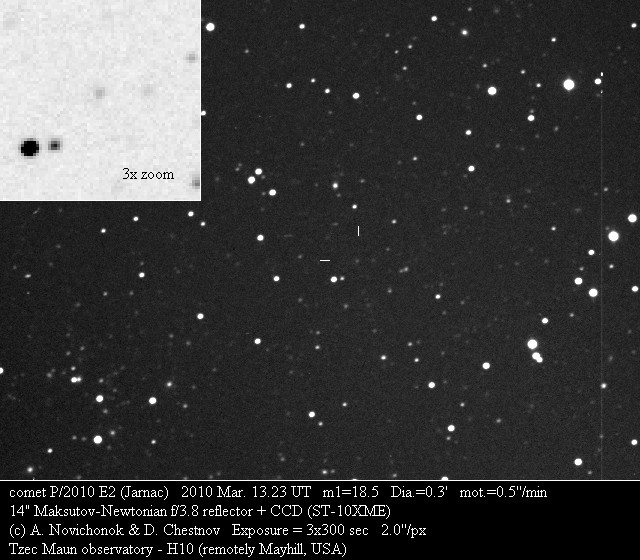
|
Comet discoverers & Comet
discoveries by amateurs 2010 - 2019 Last update: 30. November 2019 |
| Discoveries from 1978 to 1999 | Discoveries from 2000 to 2009 |
Discoveries 2020 to now |
|
|
In 2010,
with a total of 157
discoveries, 6 comets were found by amateurs:
On January the 5th. Arnold Klemola, discoverer of 1 comet and 16 asteroids, passed away at the age of 87.
On April the 18th. Miklós Lovas, discoverer of 5 comets, 42 supernovae and 2 unusual minor planets passed away at the age of 88 years.
Sad news arrived on Nov. 28th. 2019. Michael Clark, the discovered of comet 71P/Clark passed away at the age of 77 years.
An apparently asteroidal object discovered by D. H. Levy, W. Levy, and T. Glinos on Mar. 9, 2010, using a 64-cm reflector at Jarnac Observatory (Vail) has been found to be cometary after posting on the NEO Confirmation Page. D. Chestnov and A. Novichonok (remotely from Tzec Maun Observatory near Mayhill) and W. H. Ryan and E. V. Ryan (Magdalena Ridge) reported about the cometary appearance of the 18.5m object. The MPC was also able to link observations of the Mt. Lemmon Survey obtained on Feb. 17, 2010. The orbit for comet P/2010 E2 (Jarnac) shows perihelion on Apr. 7, 2010, at about 2.4 AU. The period is about 25.3 years. This is the first amateur discovery in 2010, and the 23rd comet for Levy. (IAUC 9125, MPEC 2010-E64). (Maik Meyer http://www.comethunter.de)

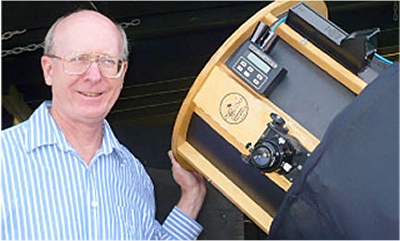
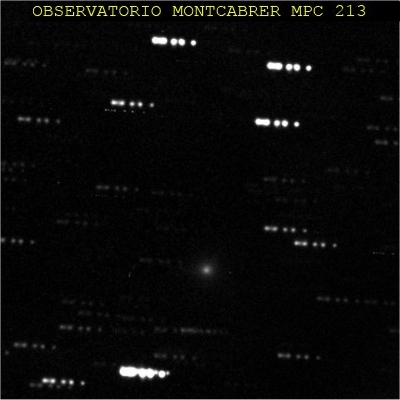
[Images: Donald Machholz, next to the telescope used in the discovery, C/2010 F4 in CCD image obtained by Ramon Naves on 27 March at 4h00 UT].
The IAUC 9132
of
March 26, 2010 reported the discovery of a
new comet made ??visually by Donald Machholz on March 23rd. with a
0.47 m reflector 77x.
with magnitude 11 and a coma of 2 '. The discovery was confirmed on Mar. 26th by itself, at a position
indicative of a rapid movement towards the Sun, and later by other
observers. Preliminary
parabolic
orbital
elements of C/2010 F4 (Machholz)
appeared on MPEC
2010-F88 on the 27th, showing perihelion on April 5th at
the distance q = 0.61 AU.
This is the 11th. visual comet discovery for Machholz, who had searched
607 hours since his last discovery C/2004 Q2. Also, this is the first
visual comet discovery after 2006. (IAUC
9127 (subscription required). (Maik Meyer http://www.comethunter.de)
J. Nomen reports that an object, discovered in the course of the La Sagra Sky Survey on Sep. 14, 2010, showed some diffuse appearance, which was later confirmed on Sep. 16. Prediscovery images by La Sagra of Aug. 13, did not show that diffuseness so clearly. After placement on the NEO Confirmation Page P. Birtwhistle (Great Shefford, England), R. Holmes and S. Foglia (Westfield, Illinois) and J. V. Scotti (Spacewatch, USA) confirmed the cometary nature of the 17.5m object. Comet P/2010 R2 (La Sagra) passed perihelion already on June 25, 2010, at about 2.6 AU. The period is about 5.5 years. It seems that this object is one of the so called 'main belt comets'. This is the 4th discovery for the amateur survey La Sagra. (CBET 2459 (subscription required), MPEC 2010-S11)
|
|
|
| [Images: Left, Jan Vales by the 0.60 m telescope of Cichocki of Crni Vrh Observatory right: P/2010 H2-like asteroidal in Virgo, one of the images in the series of the discovery. The brightest star in the field, TYC 311-1309-1, on the left edge, has magnitude 10.4] |
|
On images taken by Jan Vales in the course of the Crni Vrh Asteroid and Comet Search program PIKA, on April 16th., 2010, an unusually bright unknown object ( mag. 12.5 ) was automatically detected. The object was near opposition, in an area searched by Catalina Sky Survey ( CSS ) just a day before. As it is not usual to encounter unknown objects of this magnitude in the area recently scanned by sky surveys, a question of its nature naturally appeared. The object was placed on the Near Earth Object Confirmation Page and with the help of observations from other observatories it became apparent very soon that it is about 2 AU away. In case that this was an asteroid (as we would infer from the stellar appearance on the discovery images) this would mean a diameter in the order of 100 km, which is extremely unlikely. The remaining explanation within common knowledge of the Solar system is that it is a cometary outburst of a large magnitude. Recently a similar outburst was experienced by comet 17/P Holmes. This object has triggered massive activity of 40 observatories around the world which contributed altogether 226 observations to the Minor Planet Center ( MPC ). The observers from the CSS confirmed that the object is not visible on their images taken only 15 hours before the discovery. There was a lively debate about the nature of this object on the Minor Planet Mailing List with most plausible explanation that it is a previously unknown comet in outburst. Further observations by several observers showed that the object has a wider profile than nearby stars and Alain Maury detected faint coma on long exposures made from Chile. At 19:25 UT on April 17 the MPC issued an electronic circular MPEC 2010-H12 where the object is designated as a comet P/2010 H2. The orbit is still not very well determined, but most likely it has a semimajor axis of 3.9 AU and eccentricity of 0.2. This is similar to the orbital elements of the asteroids of the Hilda family. This object will undoubtedly be investigated further in the days to come.
Kaoru Ikeya and Shigeki Murakami - P / 2010 V1
|
|
|
(Images: Left, Kaoru Ikeya, right: Shigeki Murakami, with the telescopes used for the discovery)
C/2010 V1 was discovered visually and independently by Kaoru Ikeya (Mori-machi, Shuchi-gun, Shizuoka-ken, Japan; 25 cm reflector telescope at 39x) on November 2nd., 2010, and Shigeki Murakami ( Tohkamachi, Niigata-ken, Japan; reflector at 78x 46 cm) on November 3rd., according to the IAUC 9175 from November 3rd.
The IAUC 9176 November 4th. provided additional information, and MPEC 2010-V46 parabolic orbital elements by which the comet had passed perihelion on October 18th. at the distance q = 1.7 AU. Visual estimates with binoculars made on November 4th. offered a m1 ~ 7.5.
New astrometry ( MPEC 2 010-W29 ) showed that the comet is of short period, with elliptical orbital elements by which the comet had passed perihelion on October 11th. at the distance q = 1.6 AU, with P = 5.0 years.
An extensive story of the discovery appear on Murakami's page:
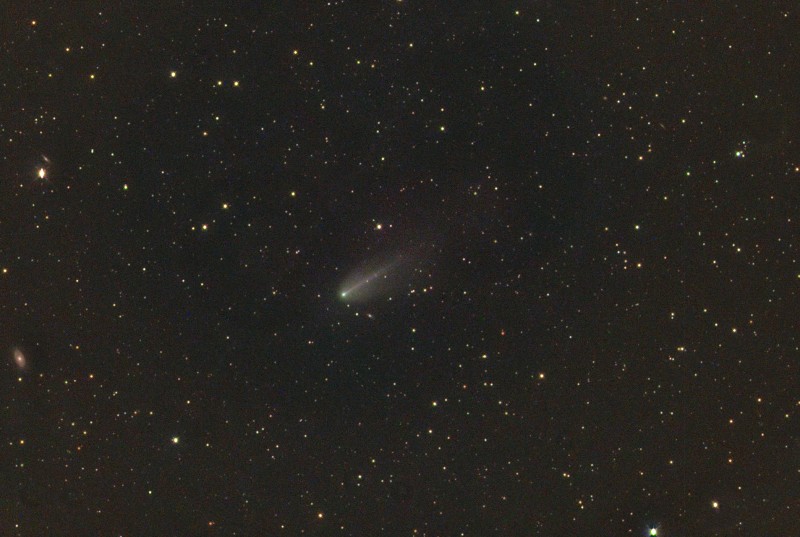
|
P/2010 V1 Virgo, November 14, 2010 |
|
[The
comet
was estimated visually m1 ~ 8.2, with a parabolic
point of about 10 'along the major axis. The brightest star in the field is SAO
139129, magnitude 7.7. The galaxy visible on the left edge is
NGC 4941, magnitude 12.0. ] Image taken with a 200 mm telescope + CCD by Michael Jäger |
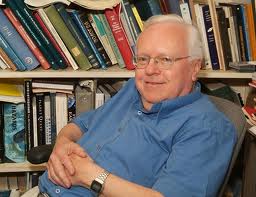
Leonid Elenin - C / 2010 X1 - P/2011 NO1
The CBET 2584 of December 13th., 2010 reported the discovery of a new comet by Leonid Elenin (Lyubertsy, Russia) on CCD images obtained remotely from the ISON-NM Observatory (Mayhill, New Mexico, USA) on December 10th. (19 mag.) with a 0.45 m reflector. It was later confirmed by other observers. The very preliminary parabolic orbital elements and ephemeris appeared on MPEC 2010-X101 , according to which the comet had passed perihelion on April 1st., 2010 at a distance q = 5.2 AU.
Subsequent astrometric orbital elements yielded improved, according to which the comet will pass perihelion on September 10th., 2011, to the interesting short distance q = 0.48 AU.
P/2011 NO1
Amateur astronomers L. Elenin (Lyubertsy) and I. Molotow (Moscow) report
their discovery of a new comet on Jul.
7th, 2011, using a remotely controlled 0.45-m astrograph at the
ISON-NM observatory near Mayhill (NM, USA). After posting on the NEO
Confirmation Page R. Holmes, S. Foglia, and T. Vorobjov (Ashmore), Foglia,
P. Miller,
P. Roche, A. Tripp, R. Holmes, R. Miles, L. Buzzi (Faulkes Telescope
North), L. Buzzi (Varese), N. Howes, G. Sostero, and E. Guido (Faulkes
Telescope South), and H. Sato (Nerpio) confirmed the cometary nature of
the 19.5m object. While the object was prepared for
announcement by the CBAT it was already announced as asteroid 2011 NO1
by the MPC. The first orbit for the still nameless comet P/2011 NO1
indicated perihelion on already on Jan. 22, 2011, at about 1.2
AU. The period is about 13.1 years. This is Elenin's
second comet discovery. (Maik Meyer http://www.comethunter.de)
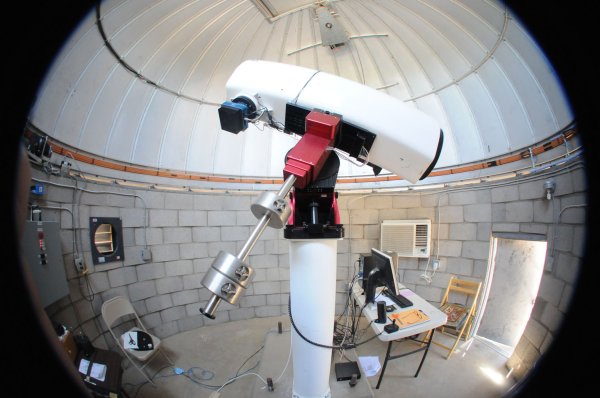
Paulo R. Holvorcem (Porto Seguro, Bahia, Brazil) and Michael Schwartz (Patagonia, AZ, USA) report their discovery of a new comet using the Tenagra III astrograph on May 26, 2011. After placement on the NEO Confirmation Page W. H. Ryan and E. V. Ryan (Magdalena Ridge Observatory), L. Buzzi (Varese), and R. Holmes, T. Vorobjov, and S. Foglia (Ashmore) confirmed the cometary nature of the 18.5 m object. The first orbit for comet C/2011 K1 (Schwartz-Holvorcem) shows perihelion on Apr. 19, 2011, at about 3.4 AU. This is the 3rd. comet discovery for Holvorcem. (IAUC 9211 (subscription required),MPEC 2011-L04) (Maik Meyer http://www.comethunter.de)
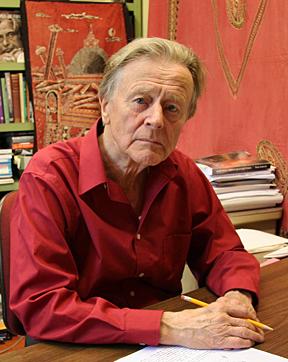
Remembering
Tom Gehrels (1925–2011)
as PDF
Artyom Novichonok and Vladimir Gerke - P/2011 R3
The Russian amateur astronomer Artyom Novichonok reports the discovery of a new comet by Vladimir Gerke and himself on images taken with a 40-cm Ritchey-Chretién reflector located at Ka-Dar observatory (near Nizhniy Arkhyz, Russia). After posting on the NEO Confirmation Page N. Howes, G. Sostero, and E. Guido (remotely using Faulkes Telescope North at Haleakala), G. Hug (Scranton), and T. H. Bressi (Spacewatch) were able to confirm the cometary nature. The first orbit for the 18.5m comet P/2011 R3 (Novichonok) indicated perihelion already on Aug. 23, 2011, at about 3.6 AU. The period is about 10.7 years. (Maik Meyer http://www.comethunter.de)Claudine Rinner - P/2011 W2 - C/2012 CH17
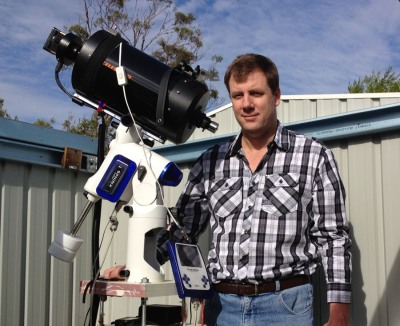

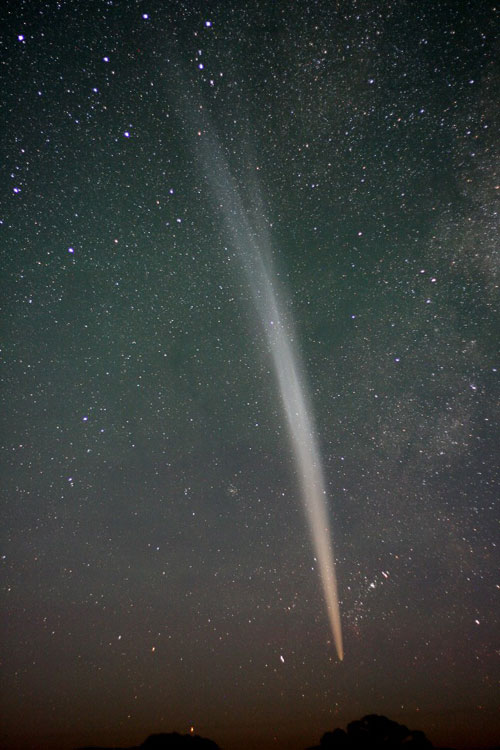
C/2012 C2 (Bruenjes): Discovered on 2012 Feb. 11, by amateur
astronomer Manfred Bruenjes (Warrensburg, Missouri, USA). 11.5m,
q=0.8
AU, T=2012 Mar. 12, CBET 3019, MPEC 2012-C44 (Maik Meyer http://www.comethunter.de)
Details about the discovery can be found on his website
or here.
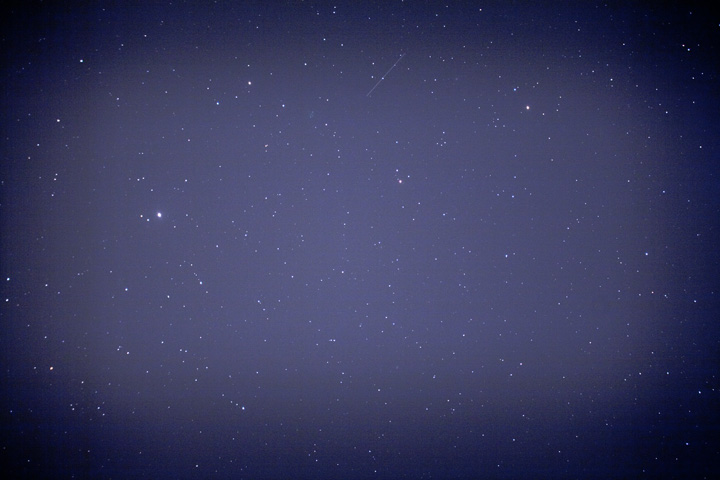 |
|
| Discovery image of C/2012 C2 |
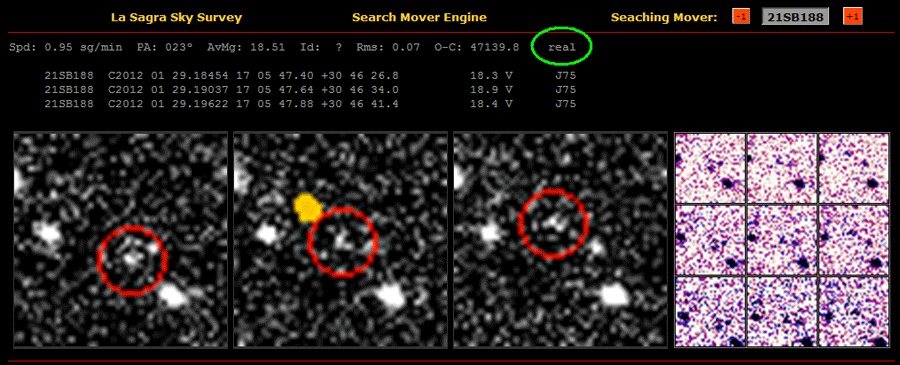
A more complete story about the discovery can be found here.
An apparently asteroidal object found on CCD images taken in the course
of the La Sagra survey by S. Sanchez, J. Nomen, M. Hurtado, J. A. Jaume, W. K.
Y. Yeung, P. Rios, F. Serra, and V. Rios with a 0.45-m f/2.8 reflector
(discovery observations tabulated below) has been reported by Gerhard J. Hahn
(Institute of Planetary Research, German Aerospace Center, Berlin) as showing
a 35" tail in p.a. 235 deg on stacked and single images taken by Stefano
Mottola using the 1.23-m telescope on Calar Alto on July 16, 17, and 18 UT.
Vitali Nevski and Artyom Novichonok - C/2012 S1 (ISON)
About the discovery...
It was first unstable night after ten ones of hard work. The endless clouds disturbed to look around the sky. That night Artyom and me decided to walk through early discovered asteroids with the most interesting orbits.But the sky became clean literally for half an hour till the dawn and it was decided to launch continious search platform on the border of Twins and Cancer – by chance.After the ending of the series Artyom went to have a rest. And I loaded platform in CoLiTec and remained to wait the processing completion learning earlier discovered astrometry of asteroids. When I started the programme of completing results the first thing I noticed among the third position objects was the bright one with unusual moving. The object was not identified with the MPC base. The unusual thing was rather slow movement relatively to the asteroids of the main zone in this region. At that moment I started to realize that so slow object did not belong to the asteroid zone and could be situated only far away behind Jupiter`s orbit. My heart missed a bit. Is it really a comet? There was nothing to do except disposing astrometry on the site NEOCP for acknowledgement. In the evening I asked Artyom to book the time for observation of the object on the 1.5m telescope of Maidanak
observatory to be sure in the comet nature of the object. Artyom and me looked through old materials,analyzed possible orbits of a new object, by then there appeared some new astrometry points. About 4 o`clock in the morning we saw the pictures – no doubt that it was a comet, classical compact one, 9x11, similar to long-period comets. We immediately sent a message to IAU. We were waiting for results. We were afraid that the object has already been discovered. But the most interesting was that the orbit of the comet started to appear with the introduction of new points of astrometry and the analysis showed perihilion near the Sun, so the brightness of the comet in the maximum could reach the full Moon. Finally on October 24 there was a circular and it was hard to believe that perihilion of the comet was 0,01 a.e. and at the maximum brightness could reach negative dimension and such one that the comet could become quite a comet of the century!
Vitali Nevski
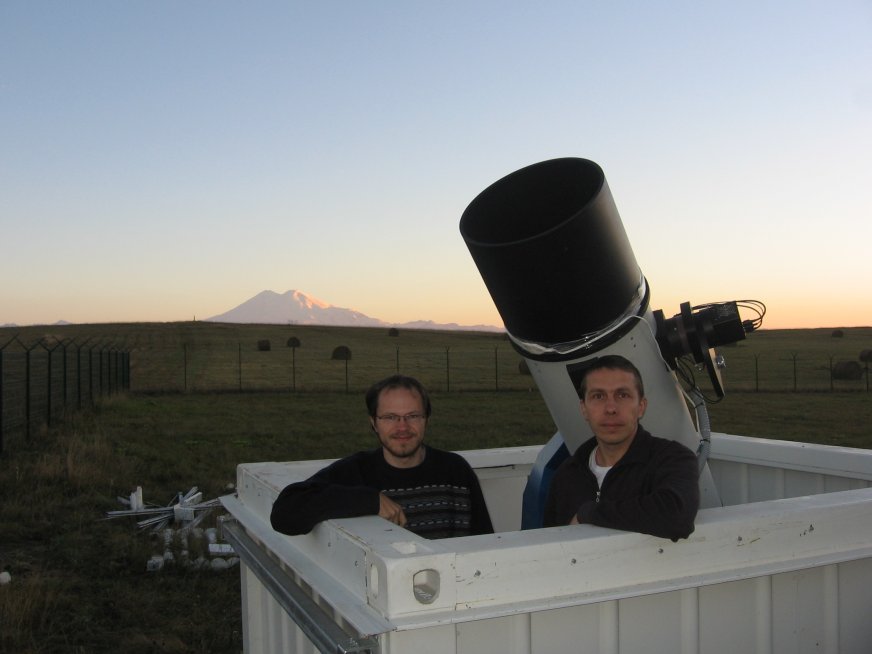 |
|
| Left: Artyom Novichonok
right: Vitali
Nevski Copyright: Vitali Nevski and Artyom Novichonok |
|
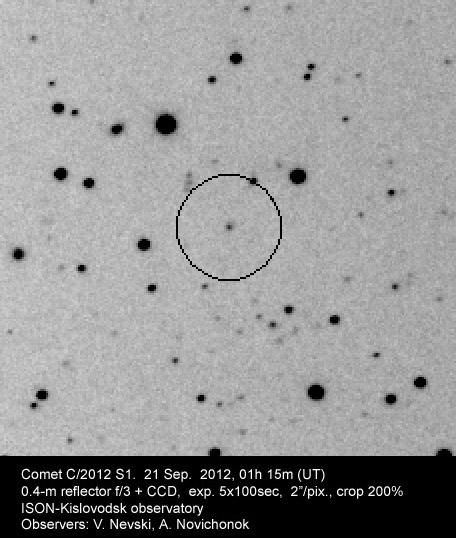 |
|
| Discovery
image
of C/2012 S1 Copyright: Vitali Nevski and Artyom Novichonok |
|
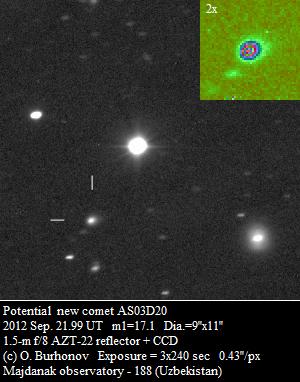 |
|
| Confirmation of
cometary activity Copyright: Vitali Nevski and Artyom Novichonok |
Discovered in the course of the amateur La Sagra Sky Survey on 2012 Sep. 23. 18m, q=1.4 AU, T=2012 Aug. 19, P=10.5 years.
CBET 3239, MPEC 2012-S79 (Maik Meyer http://www.comethunter.de)
Tomas Vorobjov , Bratislava, Slovak Republic, using remotely a 0.81-m f/7 Ritchey-Chretien reflector located at the Mt. Lemmon SkyCenter.
On three 120-s images
via the Sierra Stars Observatory Network in the course of a
minor-planet search survey undertaken as part of the International
Astronomical Search Collaboration (IASC) school campaigns. After posting
on the Minor Planet Center's NEOCP webpage, other observers have commented
on the object's cometary appearance. The discovery was announced by the Minor
Planet Center on 18 October, three days after the discovery.
Full coverage of the discovery can be found at http://ssonblog.sierrastars.com/?p=319
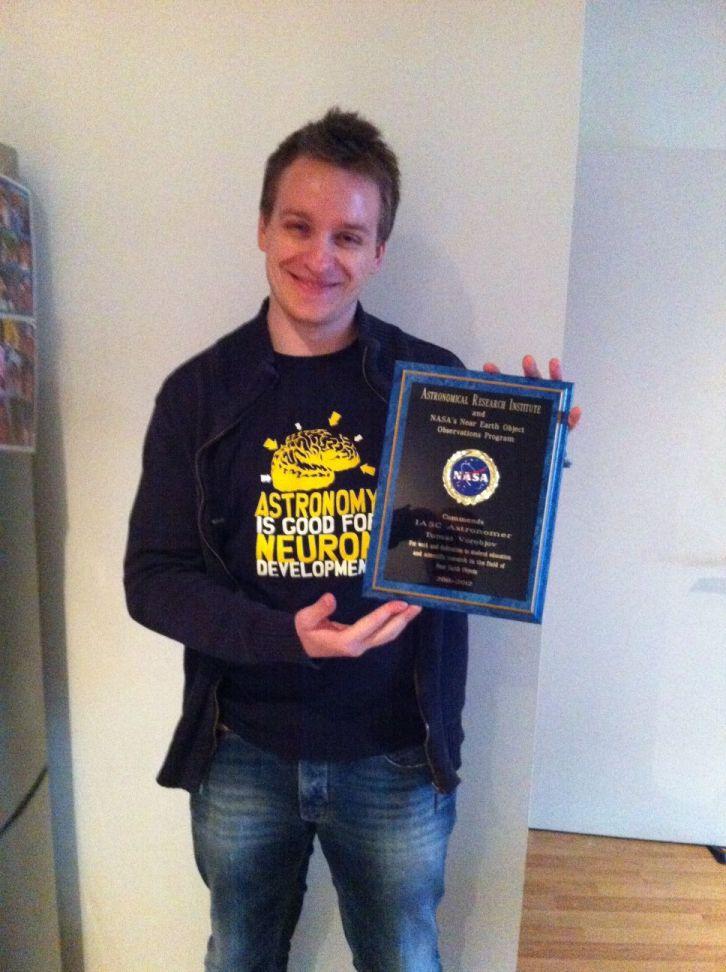 |
|
| Copyright: Tomas Vorobjov | |
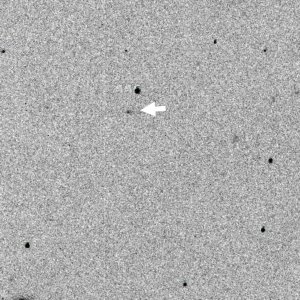 |
|
| Discovery
image
of P/2012 T7 Copyright: Tomas Vorobjov |
|
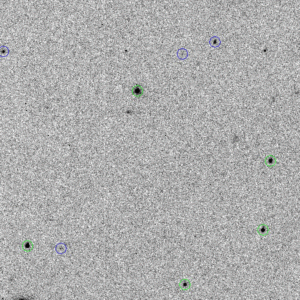 Animation of P/2012 T7 Copyright: Tomas Vorobjov |
Paulo Holvorcem - C/2013 D1 (Holvorcem)
CBET 3420 announced the discovery of a new comet by Paulo Holvorcem in the course of a sky survey using a the Tenagra III astrograph. It was discovered a 19.2 mag according to MPEC 2013-D41.
This is the 4th. comet discovery but the first
getting his name only. The other discoveries were made the late Charles
Juels or recently with Michael Schwartz.
Masuyuki Iwamoto - C/2013 E2 (Iwamoto)
CBET 3439 announced the discovery of a new
comet by Masuyuki Iwamoto ( Awa, Tokushima-ken, Japan) on CCD images taken
on March 10th and 11th using a 100 mm f/4 lens and a Canon EOS 5D DSLR
camera.
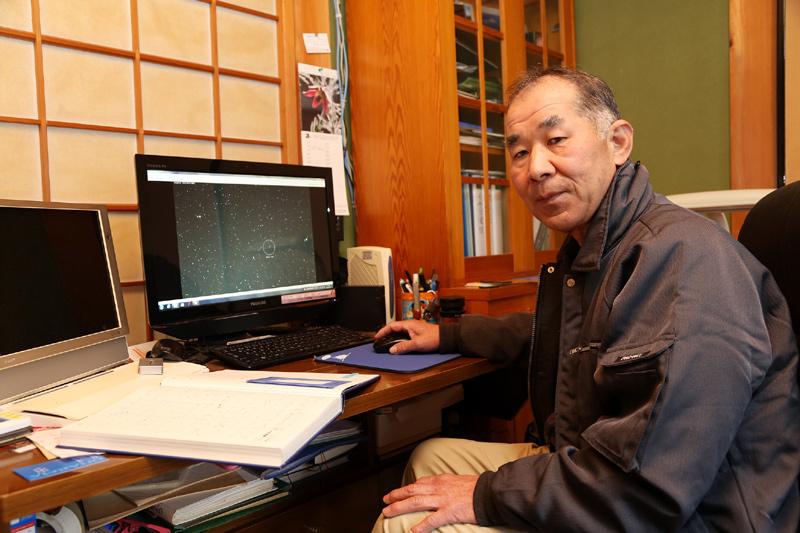 |
| Copyright: AstroArts/Hiroshi Ando http://www.astroarts.co.jp |
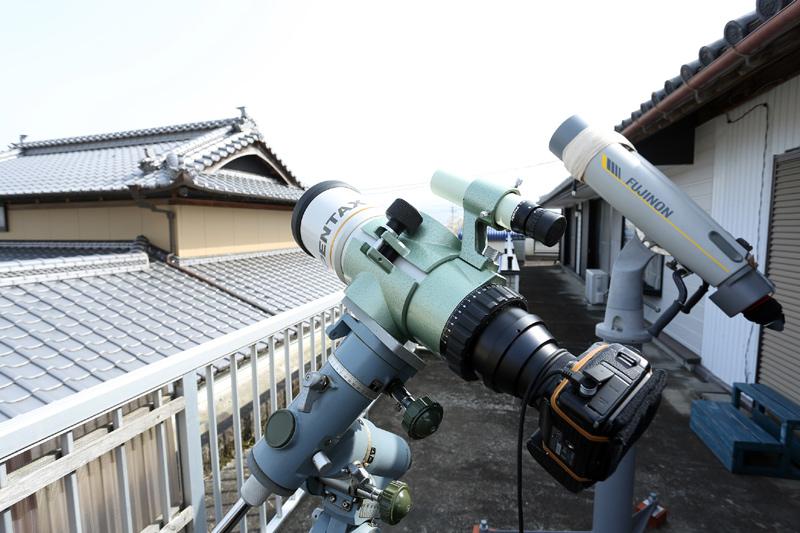 |
| Copyright: AstroArts/Hiroshi Ando http://www.astroarts.co.jp |
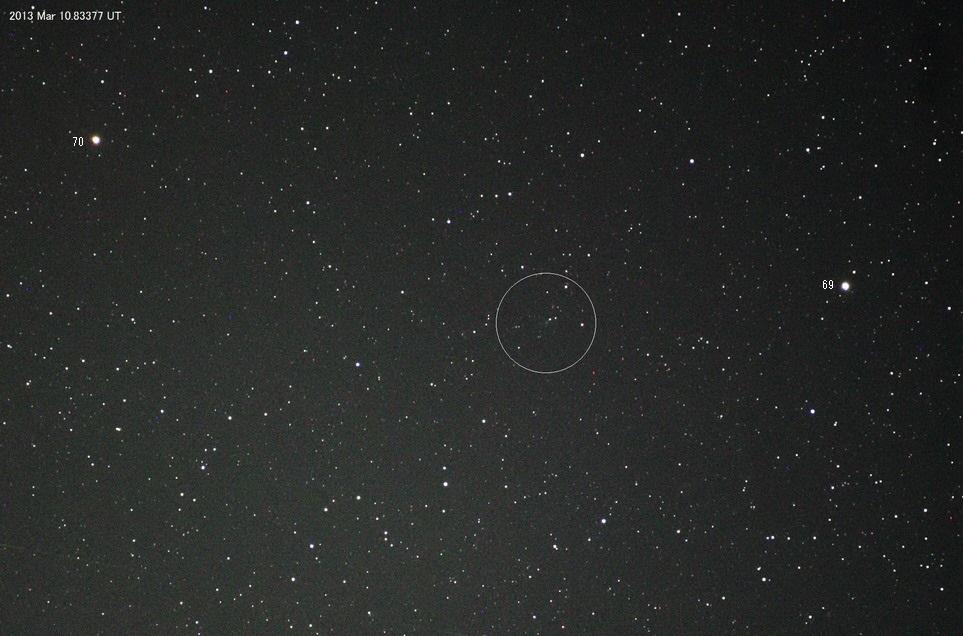 |
| Copyright: Masuyuki Iwamoto |
Discovered
in the course of the amateur La Sagra Sky Survey on 2013 Apr. 19. 18m,
coma 15", tail 16", T = 2013 June 1.3726, q = 2.62 AU, (CBET 3485),
MPEC 2013-H27
Gennadii Borisov - C/2013 N4 (Borisov)
Ukrainian amateur astronomer Gennadii Borisov discovered a brand new comet on July 8 near the bright star Capella in the constellation Auriga. The comet was confirmed and officially christened C/2013 N4 (Borisov) on July 13. At the time of discovery, Borisov was attending the Russian-Ukrainian “Southern Night” star party in Crimea, Ukraine. He nabbed the comet – his first – using an 8-inch (20-cm) f/1.5 wide field telescope of his own design equipped with a CCD camera.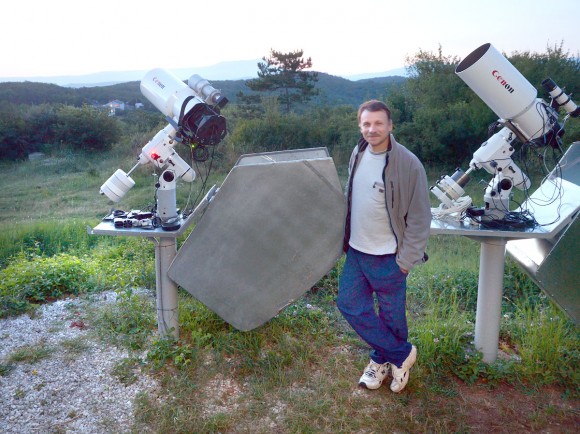 |
| Copyright: Oleg Bruzgalov |
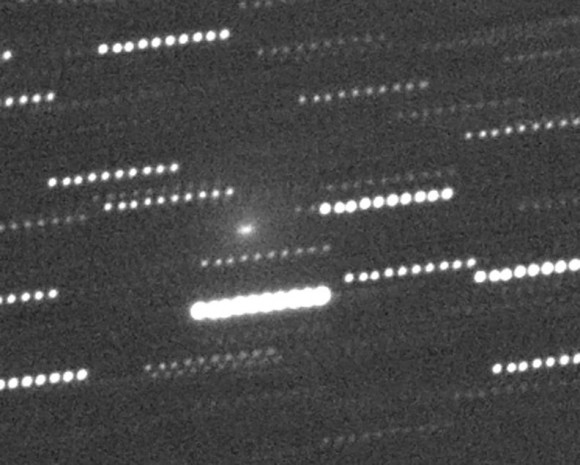 |
| Copyright: Oleg Bruzgalov |
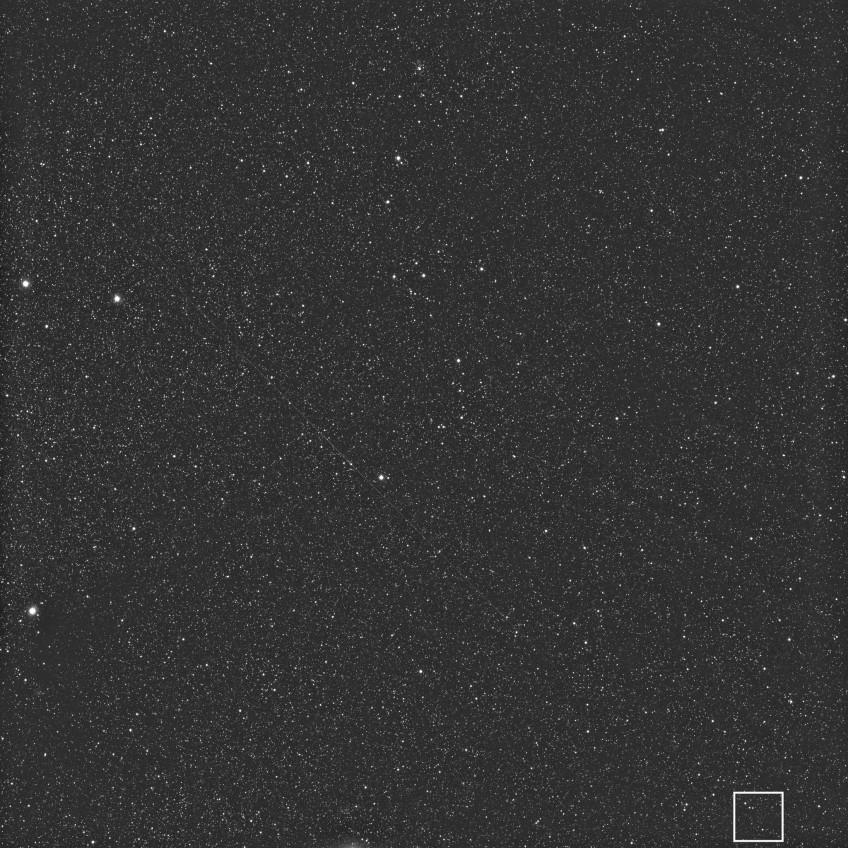 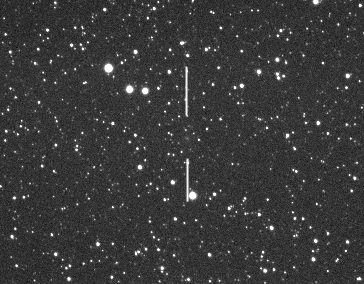 |
| Discovery image Copyright Gennadii Borisov |
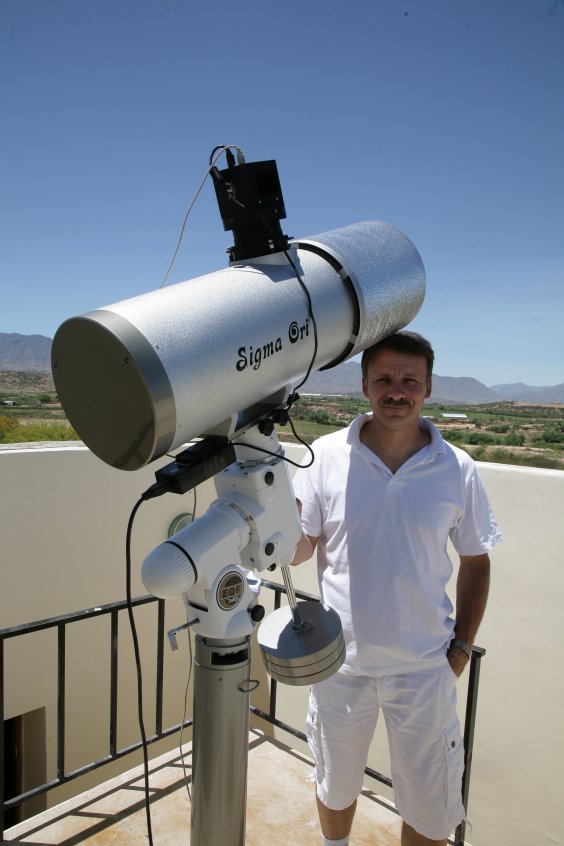 |
| Copyright Gennadii Borisov |
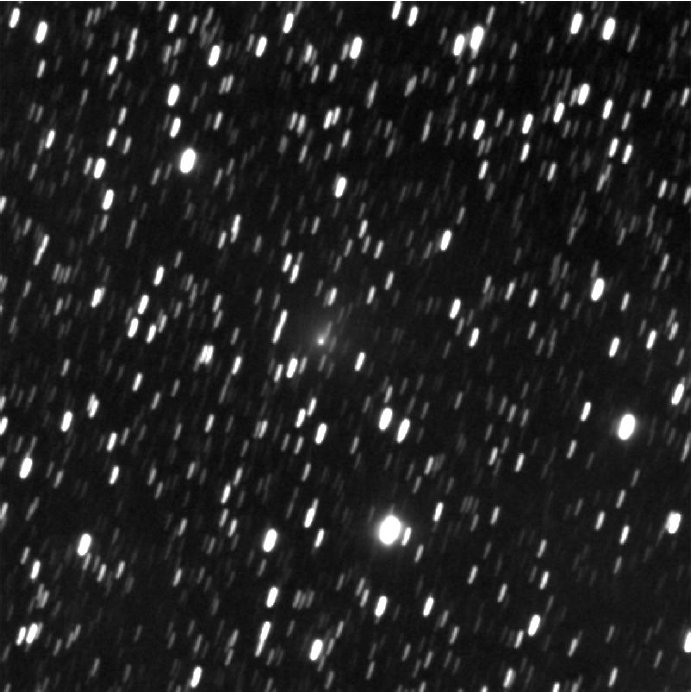
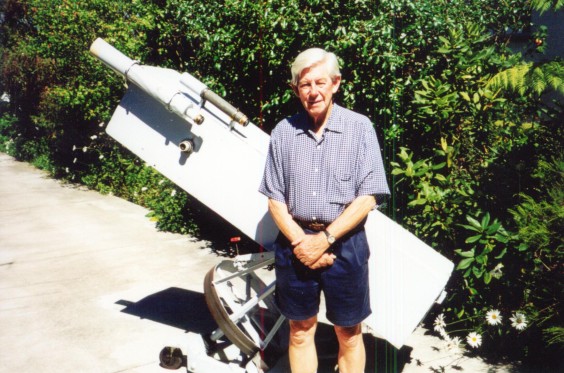
Michael Schwartz - P/2013 T2 (Schwartz)
CBET No. 3676, issued on 2013, October 22, announces the discovery of a new comet (discovery magnitude ~18.8) by M. Schwartz on CCD images obtained with the 0.41-m f/3.75 Tenagra III astrograph.Paulo Holvorcem - C/2013 U2 (Holvorcem)
CBET No. 3683 announced the discovery of a new comet (discovery magnitude ~ 19 mag.) by Paulo Holvorcem on CCD images.
Personal communication: 


C/2013 U2 : discovery images, Size: 1.9 x 2.3 arcminutes.
Copyright Paulo Holvorcem
Gennadii Borisov - C/2013 V2 (Borisov)
Personal communication: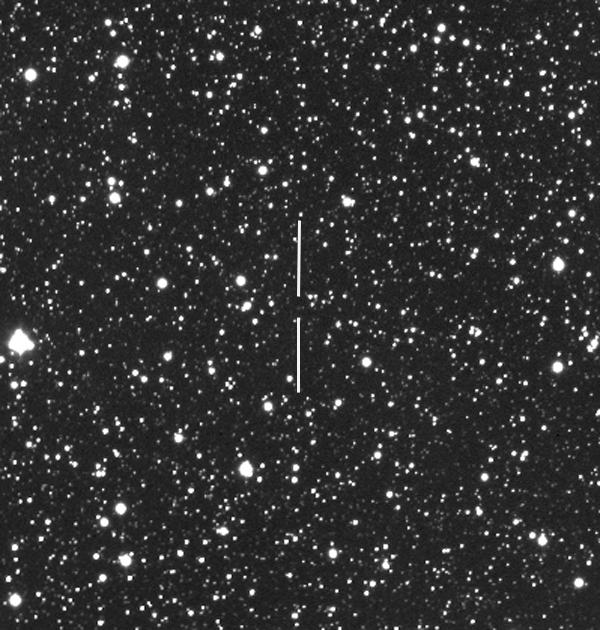
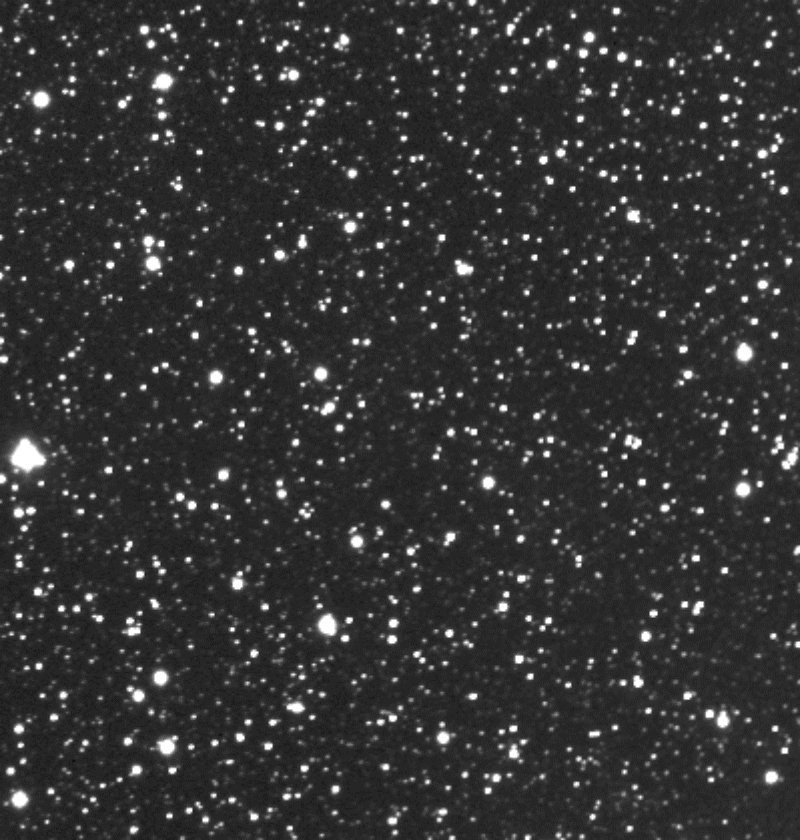
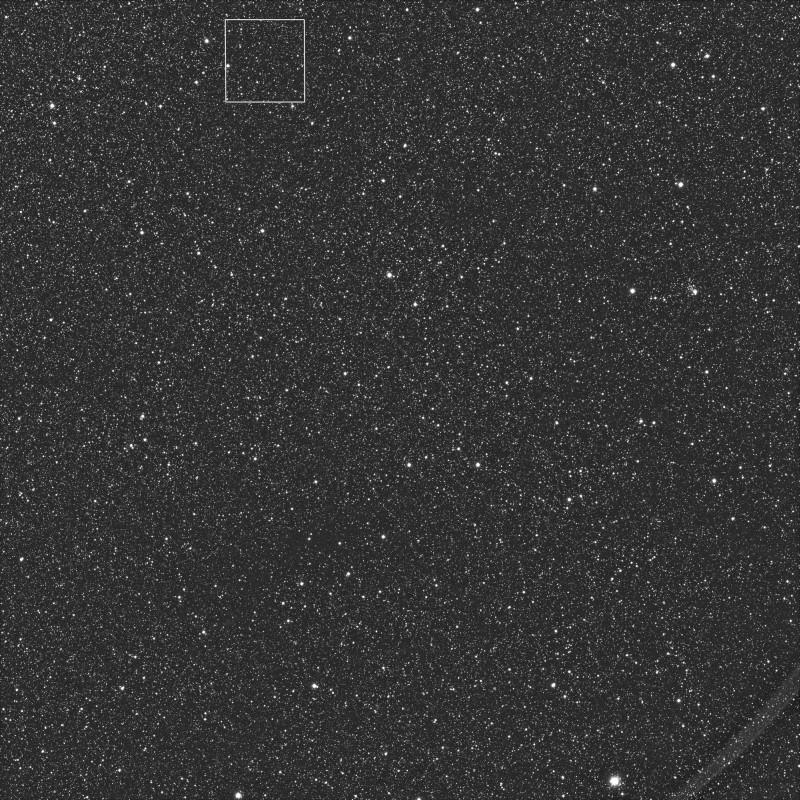
Vitali Nevski - C/2013 V3 (Nevski)
Vitali Nevski reported the discovery of a comet with a 60" coma on four180-s CCD exposures obtained on Nov. 7, with a 0.2-m f/1.5 reflector (and confirmed with images taken using a 0.4-m f/3 reflector) at the ISON-Kislovodsk observatory near Kislovodsk,Russia.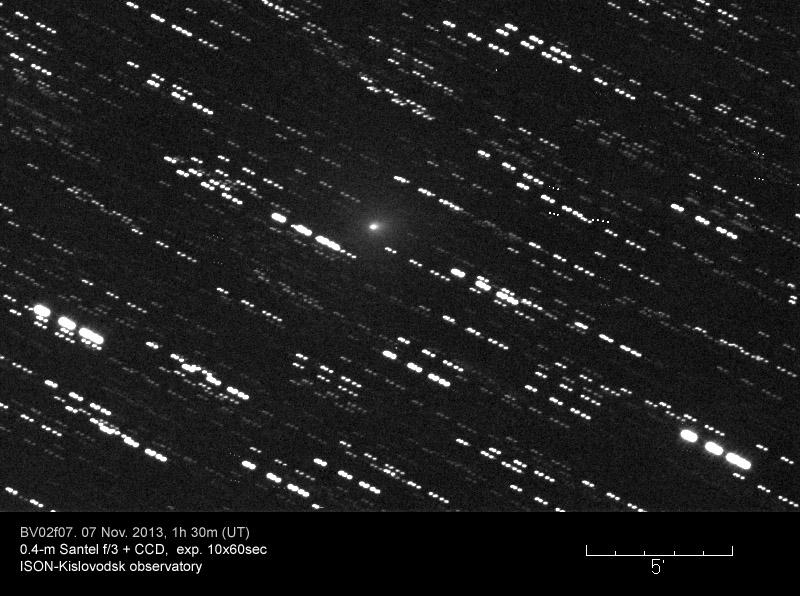
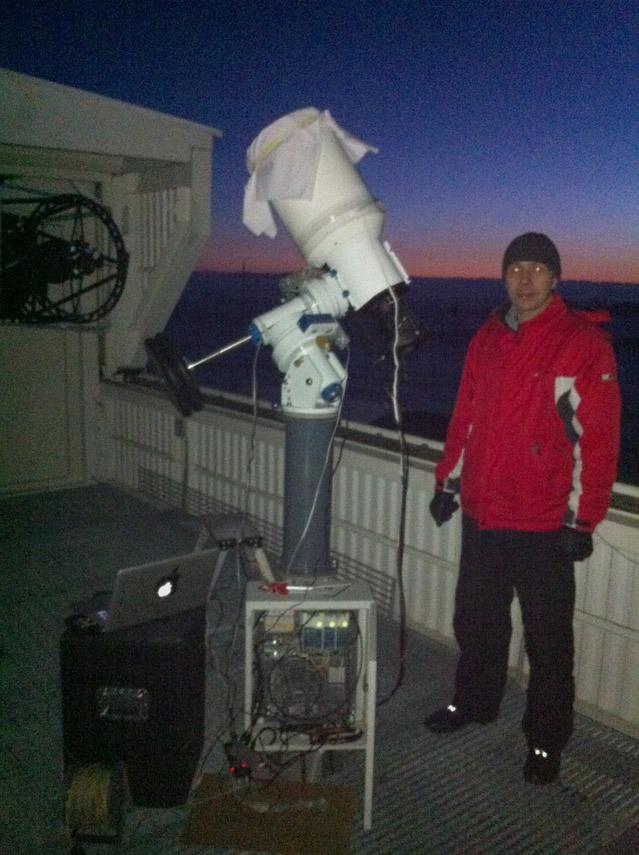
Michel Ory -
C/2013 V5 (OUKAIMEDEN)
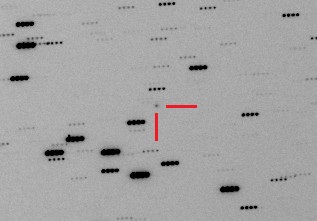
 discovery images
|
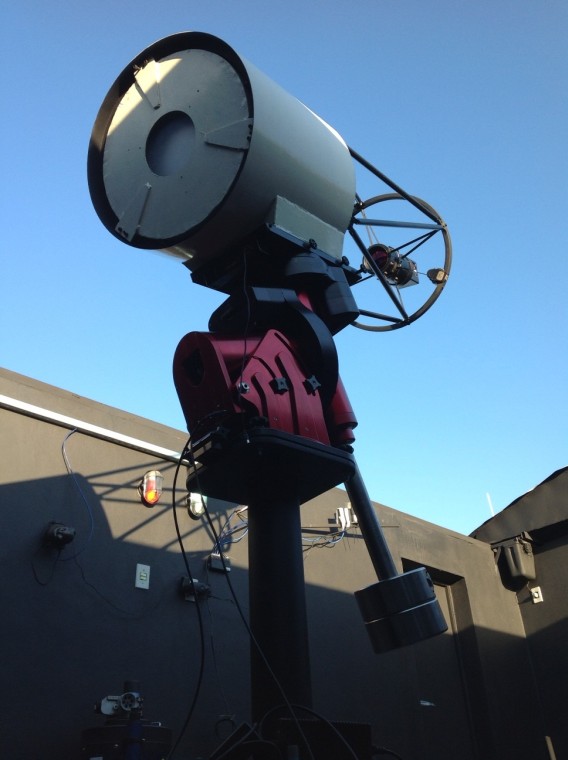 |
| Telescope used for
the discovery. |
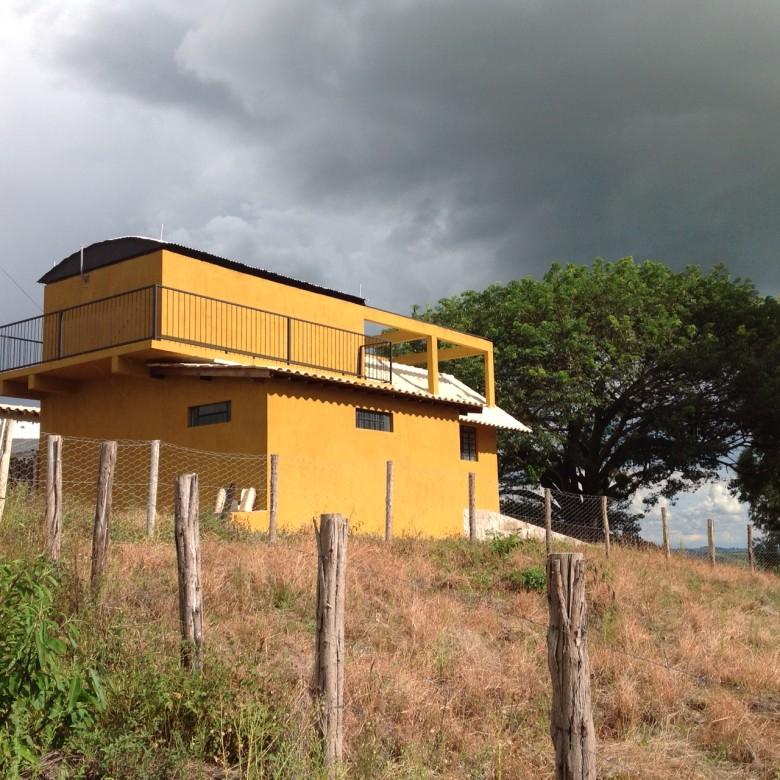 |
| SONEAR observatory |
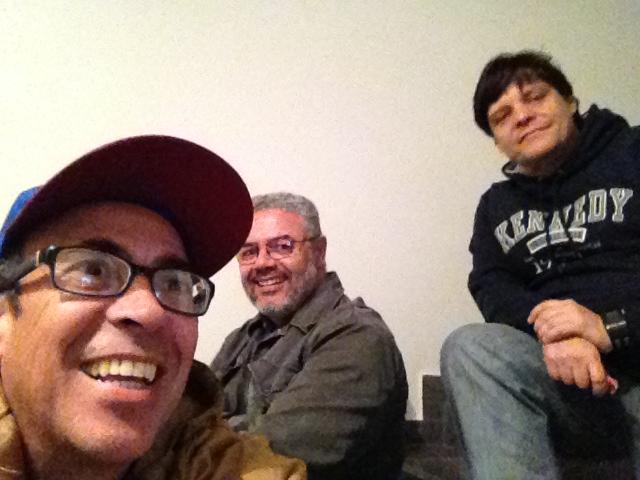 |
| SONEAR staff: Joao Ribeiro (left), Eduardo Pimentel (middle), Cristovao Jacques (right) |
Cristovao Jacques - C/2014 E2 (Jacques)
CBET No. 3828, issued on 2014, March 14, announced the discovery of a comet (~ magnitude 14.7) on CCD images taken by C. Jacques, E. Pimentel and J. Barros using a 0.45-m f/2.9 reflector at the SONEAR Observatory near Oliveira, Brazil. The new comet has been designated C/2014 E2 (JACQUES).
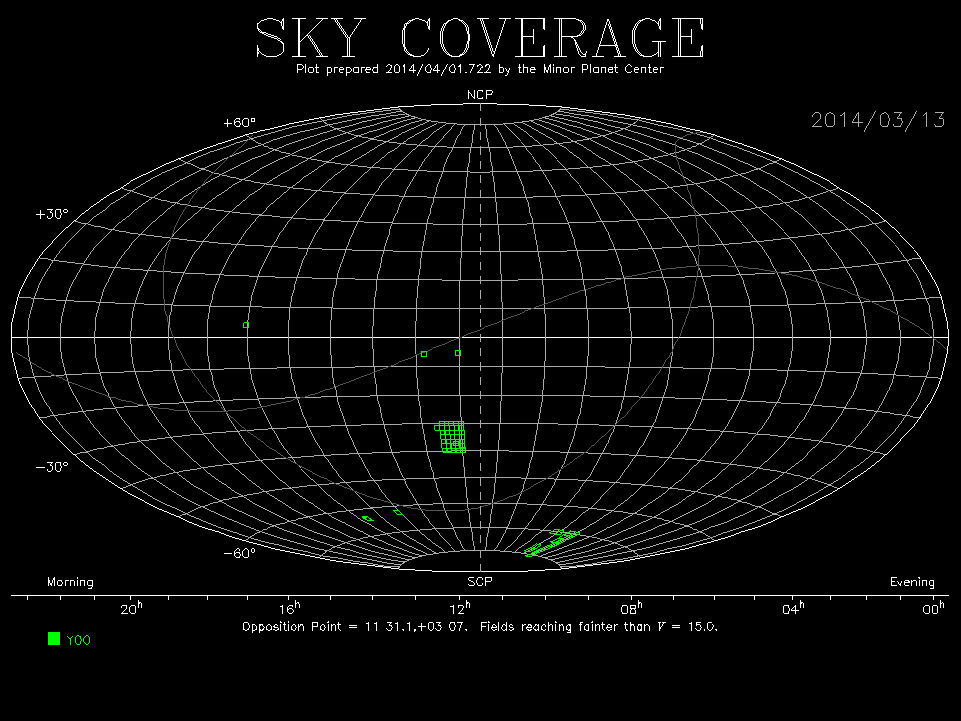
Obituary William Bradfield (1928-2014)
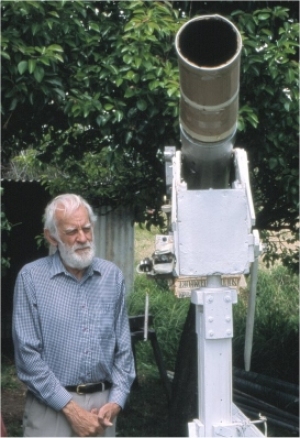 |
His remarkable list of discoveries:
|
Terry Lovejoy - C/2014 Q2 (Lovejoy)
CBET No. 3934, issued on August 18th. 2014, announced the discovery of a new comet. On August 17th., Terry Lovejoy, Birkdale, Australia discovered his 5th. comet, using a 20cm f/2.1 telescope, equipped with Hyperstar and a QHY9 CCD camera.
Gennadii Borisov - C/2014 Q3 (Borisov)
CBET No.. 3936, issued on 2014, August 24th, announced the discovery of a new comet (magnitude ~17) by G. Borisov (Observatory MARGO, Nauchnij). The new comet was found on CCD images obtained with a 0.3-m f/1.5 astrograph telescope, taken on 2014, August 22.02. The new comet has been designated C/2014 Q3 (BORISOV). This is his 3rd. discovery within 13 months !
Personal report from the discoverer:In June I started hunting with my new telescope - GenonMax ( D=300mm, F/D 1.5, FOV 4.8 x 4.8 deg).
August, 22 (01 UT) I detected a diffuse object at the edge of the frame (the edge of the frame, as always :):) ) .
But I had doubts. Fortunately, the object was also detected on the next plaste. ( areas crossed). Exp. 120 sec, Mag 17 R.
I sent the information to the MPC. Two days later, ?ircular MPEC 2014-Q38 was published.
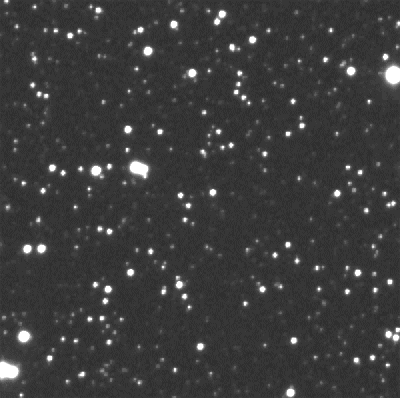
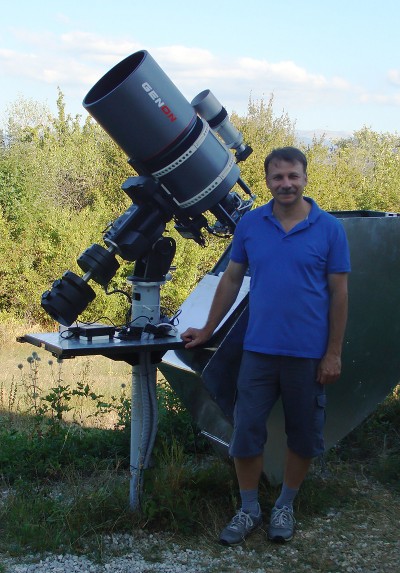
All images copyright Gennadii Borisov
Gennadii Borisov - C/2014 R1 (Borisov)
CBET No.. 39XX, issued on 2014, Sept. 6th, announced the discovery of a new comet (magnitude ~16) by G. Borisov (Observatory MARGO, Nauchnij). The new comet was found on CCD images obtained with a 0.3-m f/1.5 astrograph telescope, taken on 2014, Sept. 5th. The new comet has been designated C/2014 R1 (BORISOV).
Personal report from the discoverer:
Early in the morning September 05 ( 00:10 UT) I found a fairly bright object - 16 mag. in Constellation Cancer. Exp 105 sec. There is no doubt- new comet! And with a short tail !
I send the observations to the MPC ( MPEC 2014-R64).
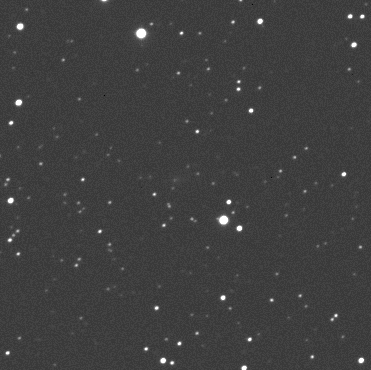
All images copyright Gennadii Borisov
Friedrich Wilhelm Gerber (1932 - 2014)
On Wednesday October 21st. the German comet discoverer Friedrich Wilhelm Gerber passed away. He discovered several comets during his stay in Argentina in the 1960s. He worked 20 years as pastor near Lucas Gonzalez, Entre Rios. Two comets were named after him as well as 2 other discoverers. 1964 L1 (Tomita-Gerber-Honda) and 1967 M1 (Mitchell-Jones-Gerber). The comets were discovered with small binoculars. He was still an active comet observer especially doing spectroscopic observations of comets. The image shows 3 comet discoverers during a meeting of the German Comet section in 2004. In a personal letter to Maik Meyer he described his 10 discoveries. Due to the remote location and the lack of information only two discoveries were credited to him. He also "discovered" the following comets.
1 Humason 1962 B 1961 f 1962 VIII
2 Ikeya 1 1963 A 1963 a 1963 I
3 Tomita-Gerber-Honda 1964 A 1964 c 1964 VI
4 Ikeya 2 1964 B 1964 1964 VIII
5 Rudnicki 1966 B 1966 g 1967 II
6 Mitchell-Jones-Gerber 1967 C 1967 f 1967 VII
7 Honda 1986 A 1968 c 1968 IX
8 White-Ortiz-Bolelli 1970 B 1970 f 1970 VI
9 Mori-Sato-Fujikawa 1976 A 1975 j 1975
10 West 1976 B 1975 n 1976
Some more details about his life and discoveries can be
found here or as PDF
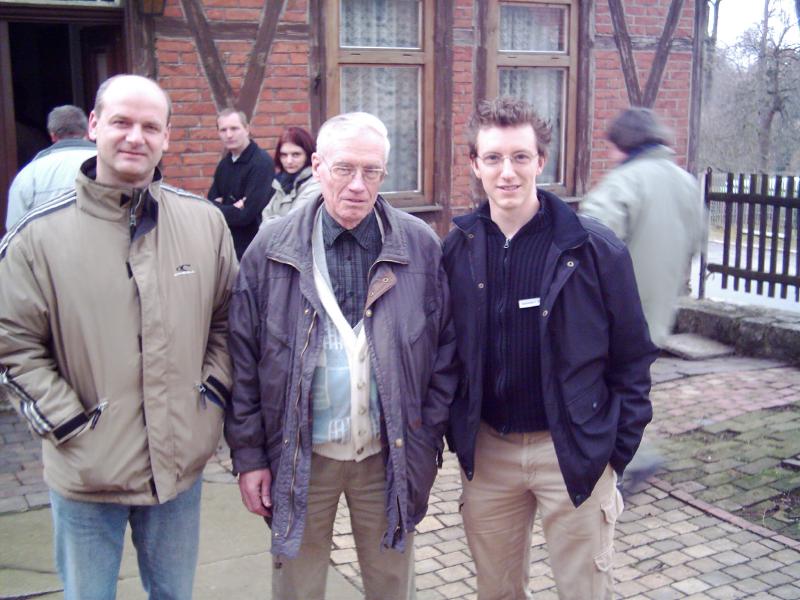
Michael Jäger -
Friedrich Wilhelm Gerber - Sebastian Hönig (Copyright unknown)
Leonid Elenin - P/2014 X1 (Elenin)
CBET no. 4034, issued on 2014, December 14,
announced the discovery of a new comet (magnitude ~18) by Leonid Elenin on
three CCD images taken on 2014, December 12 with a 0.4-m f/3 astrograph at
the ISON-NM Observatory near Mayhill, NM, USA. The new comet has been
designated P/2014 X1 (ELENIN). This is his third discovery.
Source: http://remanzacco.blogspot.de/2014/12/new-comet-p2014-x1-elenin.html
Gennadii Borisov - C/2015 D4 (Borisov)
CBET no. 4071, issued on 2015 March 3,
announced the discovery of a new comet by Gennadii Borisov on CCD images
taken with a 0.3-m f/1.5 astrograph telescope. The new comet has been
designated C/2015 D4 (Borisov). This is his fith discovery within
20 months. Great performance !
Personal report of the discoverer:
The confirmation of the comet was not very easy. It often happens with discoveries, especially with comet discoveries.
The object was found in the morning on February 23. I sent observations in MPC and they were placed on the confirmation page (PCCP).
Several observers did not see the object on the following night.
Because of the bad astrometry the object significantly shifted from the expected position (the problem of my short-focus telescope GenonMax300 / 1.5)
We had bad weather at that time.
It was a clear night only on February 25 and I tried to find almost lost object.
It was not easy but I managed to see the position of an object with a small tail quite far from the ephemeris. It's fantastic: it is a comet and it exists!
More accurate position data of the object allowed other observers to confirm it.
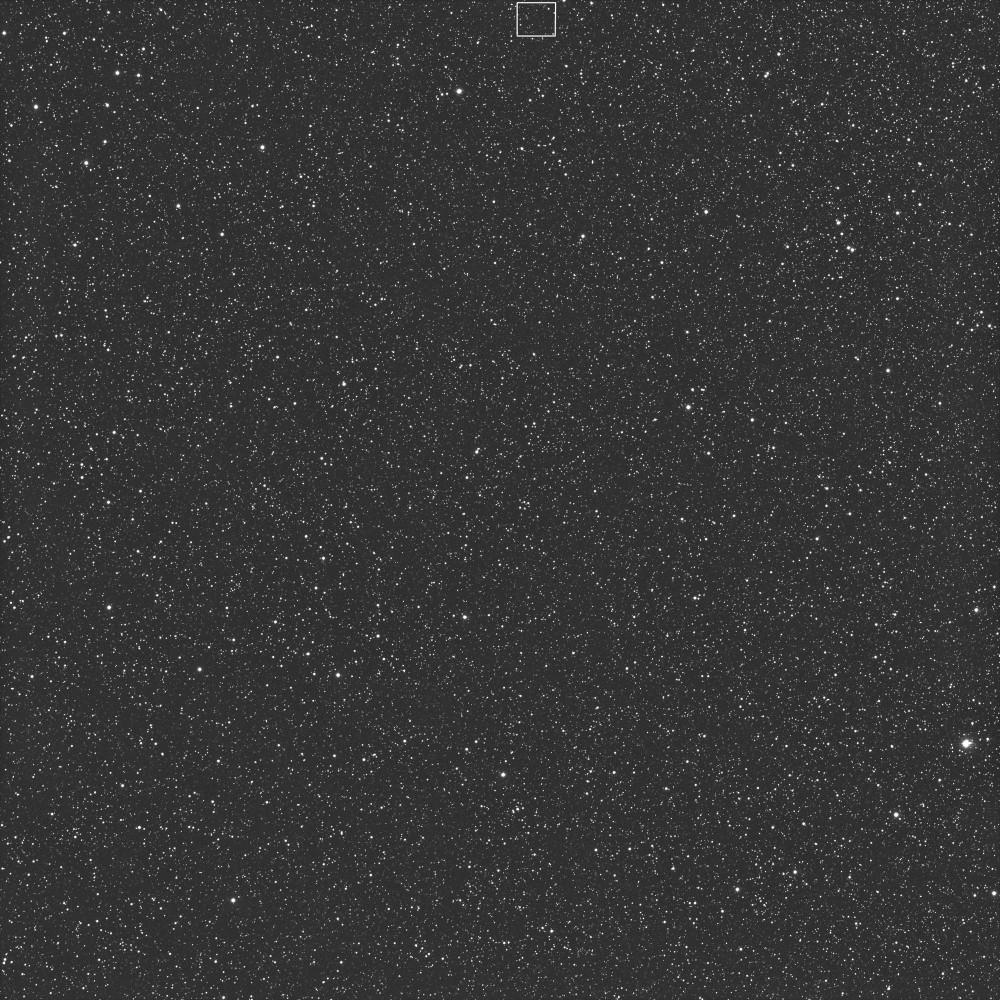
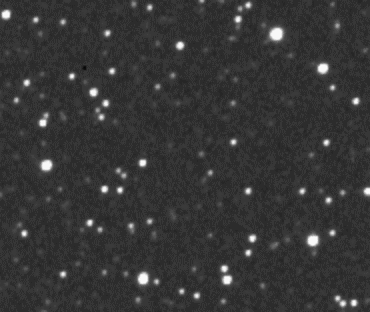
Source: http://remanzacco.blogspot.it/
Cristovao Jacques - C/2015 F4 (Jacques)
CBET no. 4085, issued on 2015, March 31,
announces the discovery of a comet (magnitude ~16) by C. Jacques
on CCD images taken on 2015, March 27.2 by C. Jacques, E.
Pimentel and J. Barros with a 0.28-m f/2.2 astrograph at the SONEAR
Observatory (Oliveira, Brazil). The new comet has been designated C/2015
F4 (JACQUES). It's his second discovery.
Source: http://remanzacco.blogspot.it/2015/03/new-comet-c2015-f4-jacques.html
From the discoverer:
March was a rainy month and we could only observe in two nights. Most of the time our search is dedicated to NEO survey, but we reserve some time to search for comets in low elongations. At the very end of the night in the last field, we discovered an object of mag. 16.5 using a 280 mm f/2.2 astrograph. The object seemed fuzzy and with a tiny tail and no doubts it was a comet.
CBAT no. 4091, issued on 2015, April 10, announced the discovery of a new comet.
Early on Apr. 5 UT (apparently before any public posting of a possible new comet on SWAN images was made)?a report was received from Xing Gao (XinJiang£¬ China) of the independent discovery of an unknown comet with a 30" coma by Guoyou Sun on images taken in twilight on Apr. 4.9 UT (discovery observationstabulated below) by Gao with a 0.11-m f/5 refractor in the course of the Xingming sky survey; they imaged about 32 square degrees of neighboring area around the comet that morning. Sun then checked online SWAN images and noticed the above-mentioned four images moving with a motion and location consistent with the Xingming images.Details: http://sunguoyou.lamost.org/en/index.html
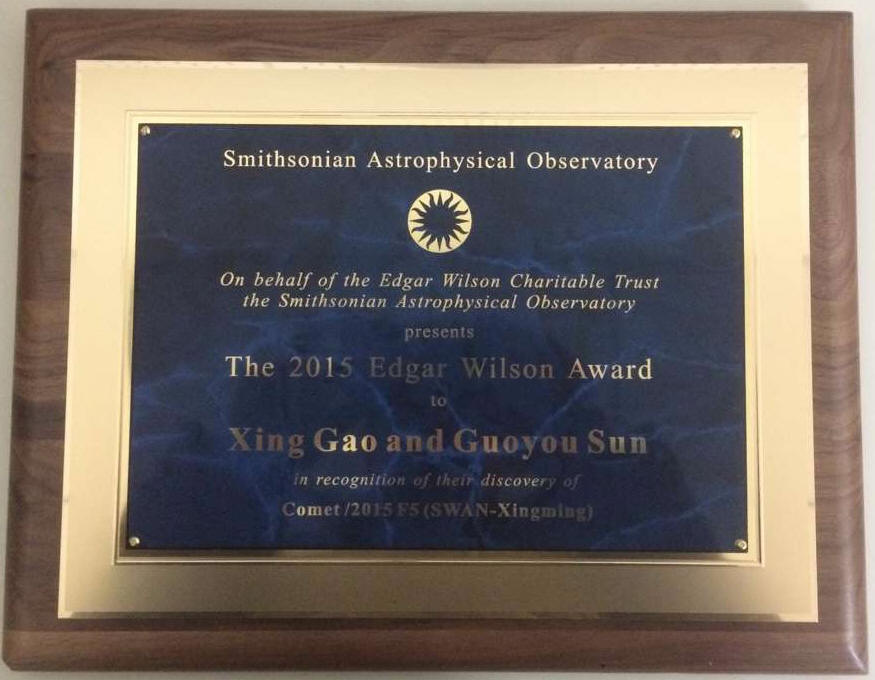
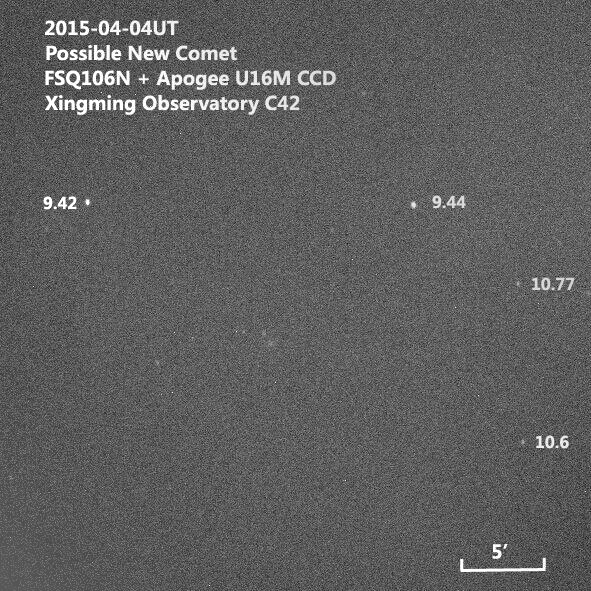

Eduardo Pimentel - P/2015 Q2 (Pimentel)
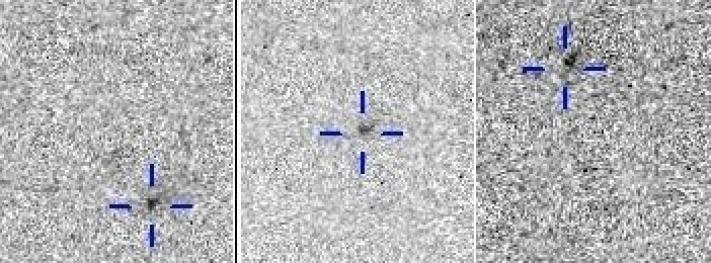
Leonid Elenin - C/2015 X4 (Elenin)
CBET nr. 4216, issued on 2015, December 08,
announced the discovery of a new comet (magnitude ~18.2) by L.
Elenin on three CCD images obtained with a 0.4-m f/3
reflector at the ISON-NM observatory near Mayhill, NM, USA on Dec. 3.5 UT.
The new comet has been designated C/2015 X4 (ELENIN). This is his forth
discovery.
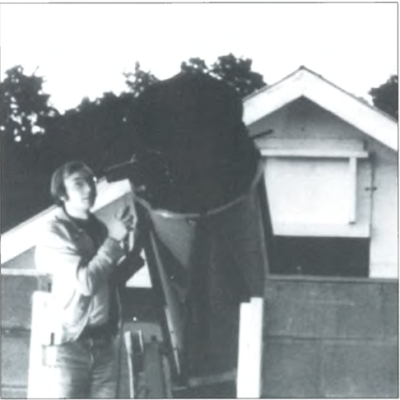 |
 |
Gennadii Borisov - C/2016 R3 (Borisov)
CBET no. 4321, issued on 2016, September 16, announced the discovery of a new comet (magnitude ~16) by G. Borisov with a 0.3m f/1.5 Genon astrograph. The new comet was found on three unfiltered CCD images ( each 70 seconds). M. Meyer, Limburg, Germany, has suggested similarity of the orbital elements of this comet with those of comet C/1915 R1 (Mellish). Until today, a linkage with the observations from 1915 have failed. This is his 6th. comet discovery.
Comment from the discoverer:Observations were made on the 30cm, F/1.5 telescope( GenonMax, exposure 70 sec). Potential object was detected in pictures made 30 minutes before dawn on 11 September.
There were doubts, so I decided to check it on the 50cm, F/1.9 telescope the next night. As soon as I saw this object again, I immediately sent astrometry
of the 1st and the 2nd nights. A 16-magnitude object moved low in the Leo constellation aprox.10-12 degrees above the horizon. This complicated its observation.
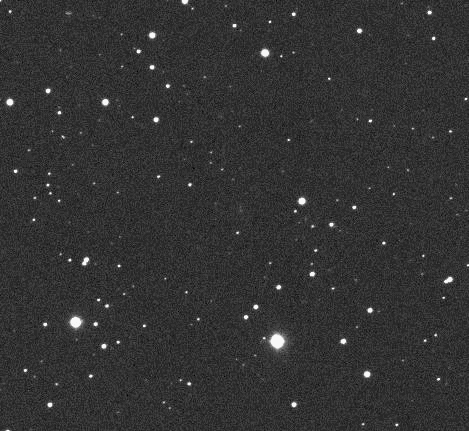
Image of the discovery ( Telescope D=300mm,F/1.5, exp 3 x 70 sec), Copyright Gennadii Borisov
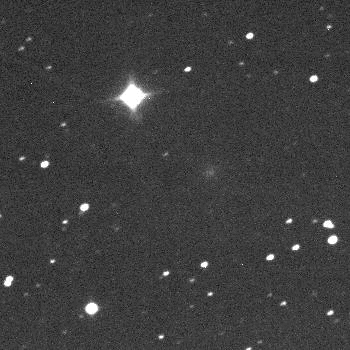
Animation from 50 cm, F/1.9 telescope, exp. 120 sec ( next night),Copyright Gennadii Borisov
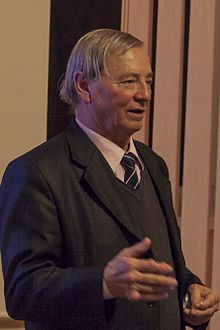
Copyright: Wikipedia
Within October 17th to 23rd the discoverer of comet C/1980 Y2 (1980u) Roy Panther passed away at a age of 90. He discovered 1 comet after searching for 33 years. More information can be found at http://www.nnhs.info/astro/astropanther.php
A video can be found on Youtube.
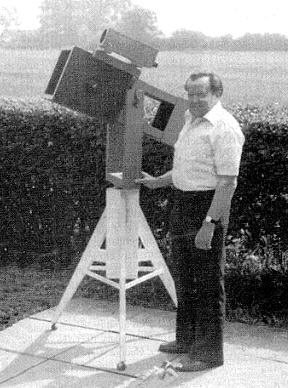
Copyright Northamptonshire Natural History Society
Leonid Elenin - C/2017 A3 (Elenin)
CBET no. 4344, issued on 2017, January 11th, announced the discovery of a new comet (magnitude ~18) by L.Elenin with a 0.4m f/2.4 Deltagraph at the ISON-SSO Observatory, Siding Spring on Jan. 5.4 UT. This is his 5th. comet discovery.
Comment from the discoverer:
I'm not a astronomer. I'm programmer and mathematician (work in Institute
of Applied Mathematics). It's my hobby and I use my software for remote
observations. I spend my money for hosting of two telescopes...
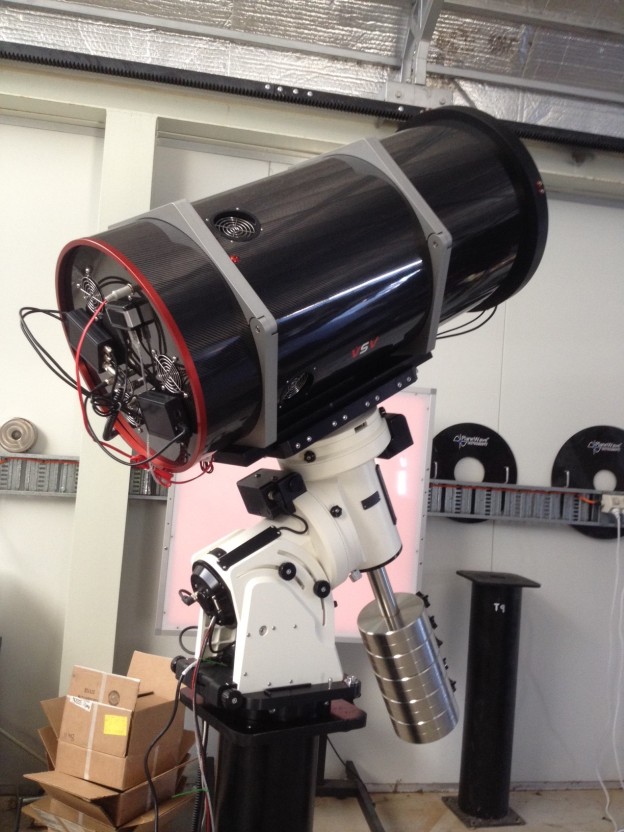
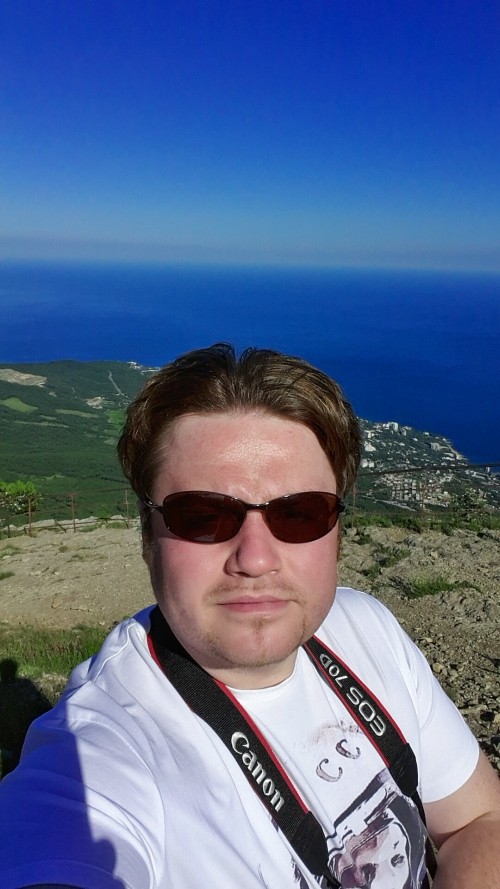



Copyright all images by Leonid Elenin
Joao Ribeiro Barros - C/2017 D2 (Barros)
CBET no. 4366, issued on 2017, March 1st. announced the discovery of a new comet (magnitude ~17.4) by Joao Ribeiro Barros. The discovery was made with a 0.45m f/2.9 telescope at the SONEAR Observatory on February 23rd.
Comment from Cristovao Jaques (member of the SONEAR team):
SONEAR staff: Joao Ribeiro (left), Eduardo Pimentel (middle), Cristovao Jacques (right)
Gennadii Borisov - C/2017 E1 (Borisov)
CBET
no.
4369, issued on 2017, March 4th. announced the discovery of a new
comet (magnitude ~17.4) by Gennadii Borisov. The new comet was detected on
three unfiltered 120-s exposures obtained on Mar. 1.10 UT with a 0.4-m
f/2.3 astrograph at the "Mobil Astronomical Robotics Genon" Observatory
(MARGO) near Nauchnij. This is his 7th. comet discovery.
Source: https://remanzacco.blogspot.de/2017/03/new-comet-c2017-e1-borisov.html
Hunting in action: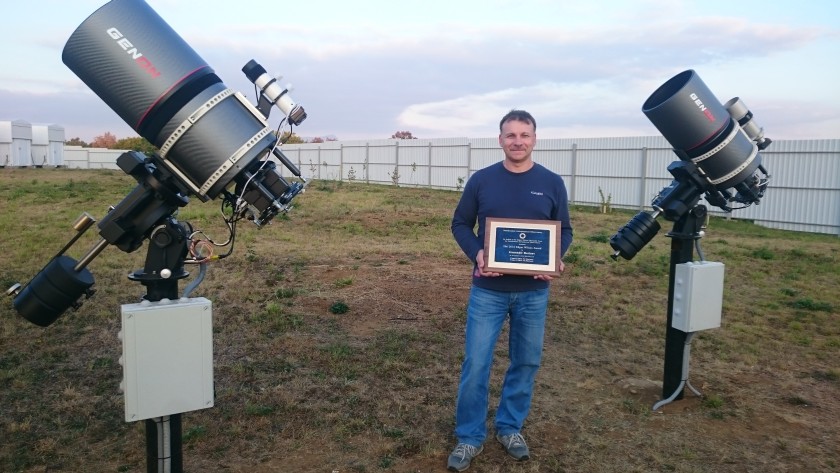
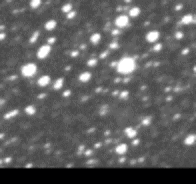
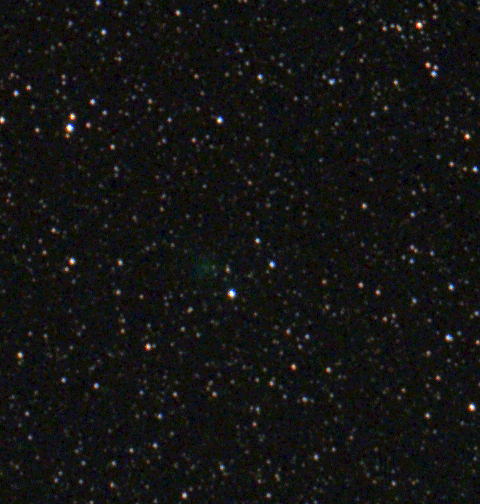
Terry Lovejoy - C/2017 E4 (Lovejoy)
CBET
no.
4373, issued on 2017, March 13, announces the discovery of a new
comet (magnitude ~15) by Terry Lovejoy. The new comet was found on 3
CCD images taken each 5 minutes apart on
March 9.68, with a Celestron C14 reflector operating at f/1.9 +
QHY9 camera. This is his 6th. discovery.
Interview with Terry Lovejoy.
From the discoverer:
The latest comet, C/2017 E4, was found on a set of 3 images made on the morning of March 10 (Local time) in the constellation of Sagittarius. Although my 6th discovery, this was the first discovery with the Hyperstar 14" Celestron Schmidt Cassegrain telescope. However, because the field of view is now smaller I must now make shorter exposures, and more of them, to cover similar amounts of sky as possible. However, I felt the extra aperture have has more than compensated especially since my location experiences quite bad light pollution being just 18 km from the centre of Brisbane, a city of more than 2 million people.
Back to the comet, it was found using MOD (Moving Object Detection) a computer program I wrote that searches sets of images for moving objects like comets of asteroids. I tend to run MOD with very high sensitivity, which means it will identify anything remotely resembling a moving object, resulting in mostly false positive detection's. In fact in crowded star-fields this can be as high as 90% false positives and so I must examine each detection manually. Nevertheless, this is huge time saver compared to examining the entire image manually. That morning a lot of the fields were in the milky way I had a large number of false detection's I had to examine, and there were also at least a dozen asteroids, but finally there was one object that had a definite coma and I knew almost certainly a comet. I then did some checks against known asteroids/comets plus some checks to eliminate internal optical reflections as a cause for the detection. This all checked out so I was certain of a new comet at this point.
I then sought independent confirmation from another observer, and looking at Messenger I could see Cristavao Jacques in Brazil was online, so I contacted him, but unfortunately dawn had started and he had closed up the observatory so there was no luck there. I then contacted Michael Mattiazzo and he was able to get a confirmation image not long after from a remote telescope in New Mexico. This was all well within the 24 hours of the actual discovery images, which is probably a record for me! The comet was then posted on the Possible Comet Confirmation Page and astrometry started to stream in over the next few days and within 3 days the orbit was known with enough certainty for it to be designated as C/2017 E4. The orbit indicates - unfortunately - this is an intrinsically small comet that probably stay quite faint (and it could even disappear altogether) but we can always hope for a better display.

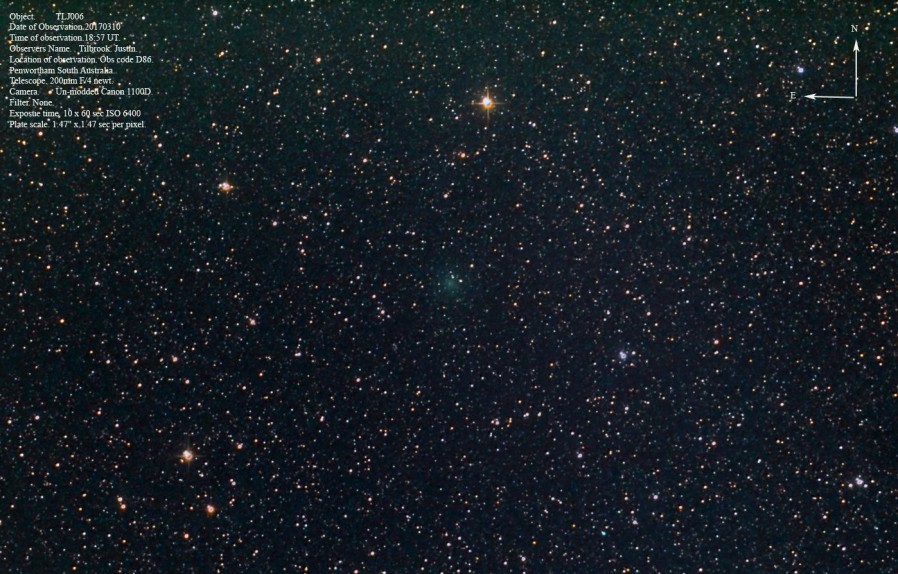
Copyright Justin Tilbrook
Goran Gasparovic - P/2017 K3 (Gasparovic)
CBET
no.
4396, issued on 2017, June 1 st. announces the discovery of a new
comet (magnitude ~19.5) by Goran Gasparovic. The new comet was found
on CCD images taken by Y. Chen and himself with an iTelescope 0.50-m
f/6.8 reflector at Siding Spring on May 22, with confirming observations
obtained two nights later with an iTelescope 0.43-m f/6.8reflector also at
Siding Spring.
After the comet was posted on the Minor Planet
Center's PCCP webpage, M. Kusiak (Zywiec, Poland) communicated that
pre-discovery CCD images taken by M. Gedek, M. Zolnowski, R. Reszelewski,
and himself with a 0.25-m f/3.6 reflector at the Polonia Observatory at
San Pedro de Atacama, Chile, on May 21.1 UT show the object to be slightly
diffuse with coma size 8" in 3".5 seeing, the total magnitude being
18.7-19.6.
CBET
no.
4399, issued on 2017, June 1st. announced the discovery of a new
comet (magnitude ~17.5) by Cristovao Jaques. The discovery was made with a
0.45m f/2.9 telescope at the SONEAR Observatory on May 29th. The discovery images
were taken by E. Pimentel, J. Barros, and himself with a 0.45-m f/2.9
reflector at the SONEAR Observatory at Oliveira.
Amateur astronomer and comet discoverer Thomas J. Bopp passed away on Januar 5th. 2018. He co-discovered the famous comet Hale-Bopp in July 1995 incidentally while observing in the Arizona desert.
https://en.m.wikipedia.org/wiki/Thomas_Bopphttp://www.skyandtelescope.com/astronomy-news/people-places-and-events/thomas-bopp-1949-2018/
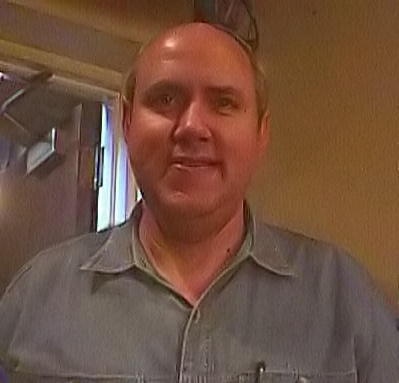
Joao Ribeiro Barros - C/2018 E2 (Barros)
CBET
no.
4495, issued on 2018, March 16th. announced the discovery of a new
comet (magnitude ~19.4) by Joao Ribeiro Barros. The
discovery was made with a 0.45m f/2.9 telescope at the SONEAR Observatory on March 12th. on images taken by
Cristovao Jacques.
The object had a diffuse coma 15" in diameter
in three stacked 60-s images.
Don Machholz - Shigehisa Fujikawa - Masuyuki Iwamoto- C/2018 V1 (Machholz-Fujikawa-Iwamoto)
CBET no. 4572, issued on 2018, Nov. 12th. announced the discovery of a new comet. Also the MPEC 2018-V151 contains details.
It's the second comet discovery of Masuyuki Iwamoto. It's already the 7th. comet discovery of Shigehisa Fujikawa (Source).
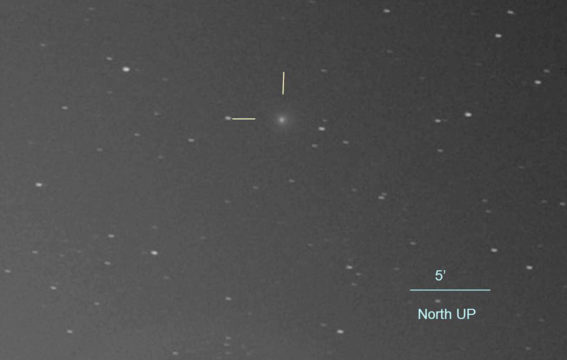
Copyright: Toru Yusa
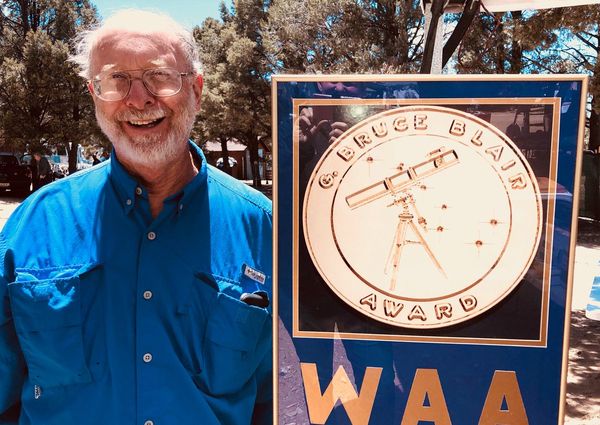    |
| Copyright Don Machholz & AstroArts/Hiroshi Ando http://www.astroarts.co.jp & Unknown |
Masuyuki Iwamoto- C/2018 V1 (Iwamoto)
CBET no. 4588, issued on 2018, Dec. 20th. announced the discovery of a new comet. It's the third comet discovery of Masuyuki Iwamoto, the last one happend just one month ago.
COMET C/2018 Y1 (IWAMOTO)
I. Endoh, National Astronomical Observatory of Japan, Tokyo,
reports the discovery of a comet of magnitude 14.5 by
Masayuki Iwamoto (Awa, Tokushima, Japan) on two 60-s CCD
exposures obtained around Dec. 18.84 UT with a 10-cm f/4.0
Pentax SDUF II telephoto lens and a Canon EOS 6D camera. Iwamoto reported
the approximate position as R.A. = 14h17m45s, Dec. = -24d44' (equinox J2000.0).
S. Nakano, Sumoto, Japan, reports that the discovery images show a
blue coma.
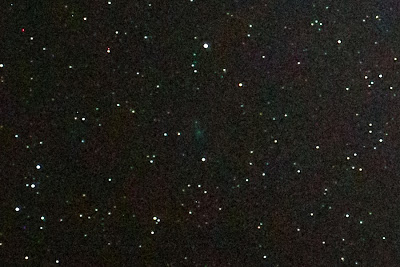
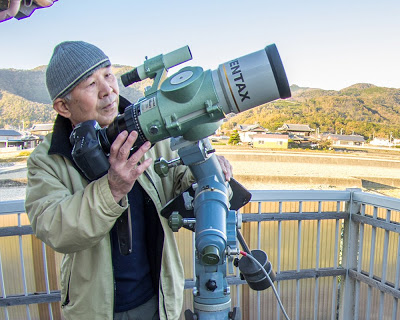
He discovered 42 supernovae, 5 comets (including 93P & 184P) and 2 unusual minor planets at the Konkoly Obs. between 1964 and 1995.
Source: K. Sárneczky
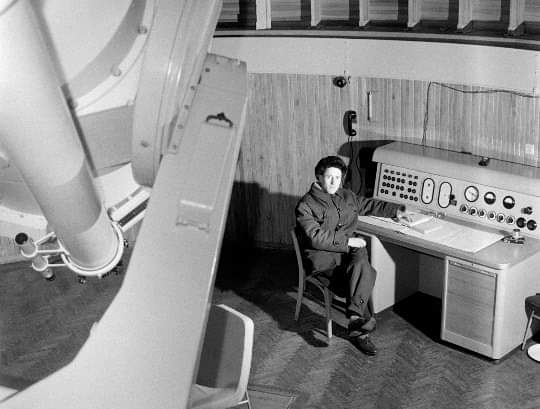
The discoverer of comet 68P/Klemola (returning in Fall 2019) died at the age of 87. He discovered it on Oct. 28th. 1965 from Argentina in the course of the Yale-San Juan Southern Proper Motion Survey.
Source: https://news.ucsc.edu/2019/01/klemola-in-memoriam.htmlor
as PDF
More https://www.ucolick.org/public/telescopes/astrograph.html

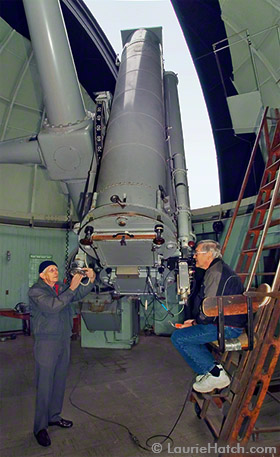
CBET no. 4666 issued on Sept. 12th. announced the discovery of a new comet named after amateur astronomer Gennadii Borisov. It is his 8th. discovery. He discovered it on August 30th. only 2 days before he recovered comet P/2008 Y1 = 2019 R1 (Boattini) with a 65cm f/1.5 telescope designed by himself. The new comet was found on CCD images at 18 mag. The orbit has a e = 3 as announced here.
From the discoverer:
The parameters of the telescope: D = 650 mm, F/1.5, FOV: 2x2 deg. CCD: FLI ML16803, 1.87 "/pixel History of discovery: I received the first images of the new object on August 30. Astrometry showed 100% NEO rating. I sent the astrometry to MPC. My observations and data from other observatories later showed an unusual orbit, e=3 . Everyone thought it was a mistake . But, when observations became more, Minor Planet Center agreed that it is a unique comet. The result was a circular: https://minorplanetcenter.net/mpec/K19/K19RA6.html Further observations will help clarify the orbit in the future.
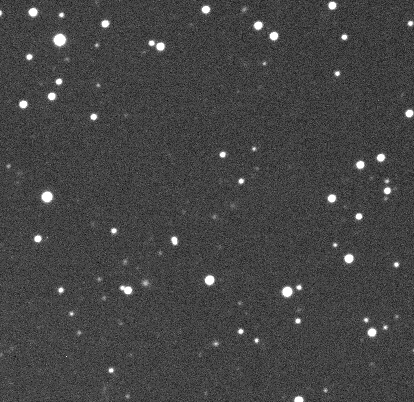
Animation 9 x120 sec. Copyright Gennadii Borisov
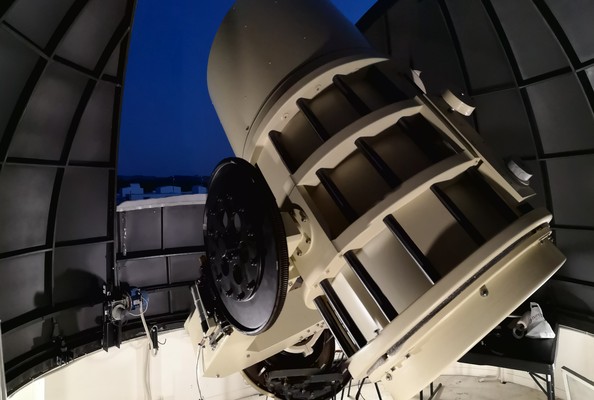
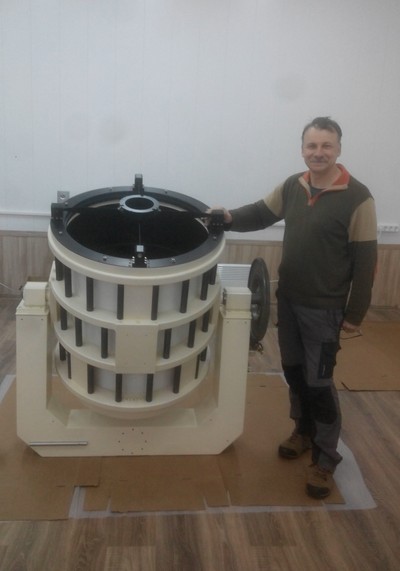
Copyright: Gennadii Borisov
CBET no.4696 issued on Nov. 8th. announced the discovery of a new comet Borisov. This is his 9th. discovery.
This object was reported as possibly cometary on Nov. 2 by G. Borisov (L51), noting a 7-arcsecond condensed coma and no tail, and was placed on the Possible Comet Confirmation Page. Its cometary nature was confirmed on Nov. 3 by D. Durig (850), who noted a 6 to 8-arcsecond coma based on stacks of 200 and 300 10-second exposures.
From the discoverer.
I looked up Sky Coverage for big surveys and saw that they were not observing the Milky way. And discovered my ninth comet in the Milky way. This comet is not the brightest of all previously discovered. Also, this comet is the second with a large elongation. Comet Date UT Elong. Mag. --------------------------------------------------- C/2013 N4 (Borisov) 2013 07 08.98 30 17 C/2013 V2 (Borisov) 2013 11 06.01 132 17 C/2014 Q3 (Borisov) 2014 08 22.01 60 17 C/2014 R1 (Borisov) 2014 09 05.05 38 16 C/2015 D4 (Borisov) 2015 02 23.10 37 17 C/2016 R3 (Borisov) 2016 09 11.06 32 16 C/2017 E1 (Borisov) 2017 03 01.10 55 17 C/2019 Q4 (Borisov) 2019 08 30.04 38 18 C/2019 V1 (Borisov) 2019 11 01.98 126 19.5 ---------------------------------------------------
Copyright: Gennadii Borisov Copyright: Julia Zhulikova
On Nov. 28th. the sad news of the death of the discoverer of comet 71P/Clark was published on the comets-ml. According to comet discoverer Rodney R.D. Austin, Michael Clark passed away in Melbourne, Australia at the age of 77.
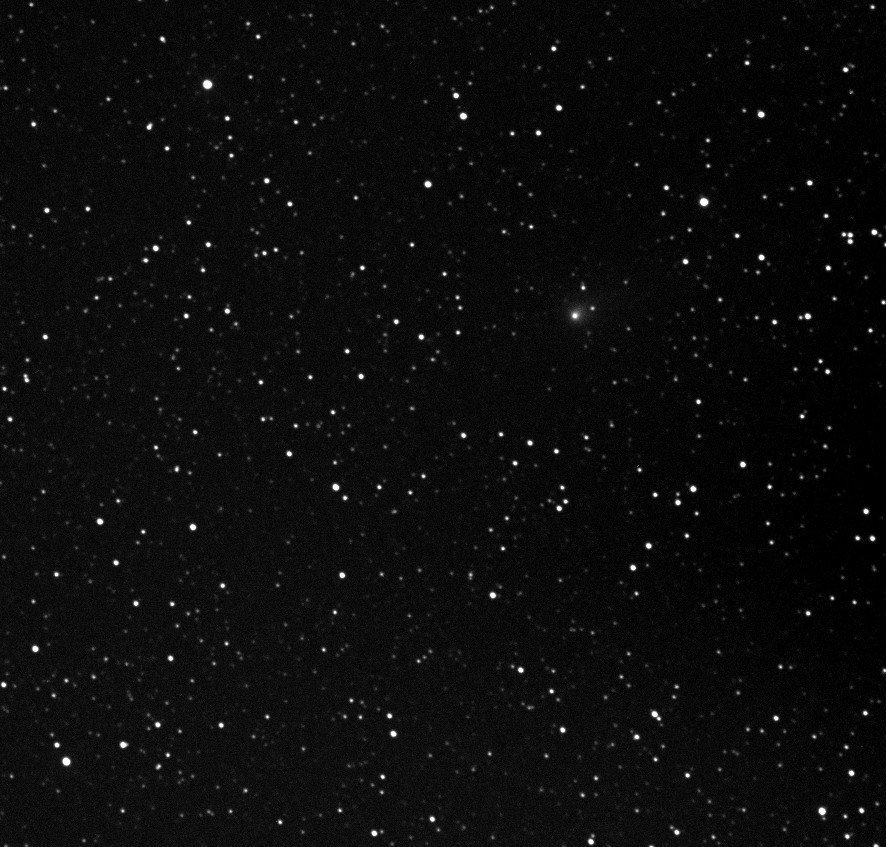
Links
Central Bureau for Astronomical Telegrams (CBAT - IAU).
Draft Guidelines for Comet Discoveries (Jonathan Shanklin, BAA).
Comet Seeking (William Bradfield, in the page of the ASSA).
David Levy's Home Page (Jarnac Observatory).
Comet Hunting Techniques (Vello Tabur).
Come osservare le comete - La ricerca di comete(Mauro Vittorio Zanotta).
Catalogue of Comet Discoveries Home Page (COCD, Maik Meyer, Germany).
Comet Hunting Resources on the Web (COCD, Maik Meyer).
Award 2003/2004: V. Tabur, W. Bradfield (IAUC 8372).
Award 2004/2005: R. Tucker, D. Machholz (IAUC 8554).
Award 2005/2006: C. Juels and P. Holvorcem, J. Broughton (IAUC 8730).
Award 2006/2007: J. Broughton, D. Levy, T. Lovejoy (IAUC 8854).
Award 2007/2008: T. Chen and X. Gao (IAUC 8962).
Award 2008/2009: R. Holmes, S. Maticic, M. Ory, K. Itagaki, D. Yi (IAUC 9066).
Professional Surveys

Image: LINEAR
Program
Pan-STARRS Panoramic Survey Telescope &
Rapid Response System
The Spacewatch Project (University of Lunar Arizona's and Planetary Laboratory)
Catalina Sky Survey (CSS) (University of Arizona)
The LINEAR Program (Lincoln Near Earth Asteroid
Research - MIT, 1998 - 2005) - Not longer in operation !
Near-Earth Asteroid Tracking (NEAT) Home Page - (1995 - 2007) Not longer in operation !
Lowell Observatory Near-Earth-Object Search (LONEOS) - (1993 - 2008) Not longer in operation !
Siding Spring Survey (SSS) (Australian National University - University of Arizona, stopped in 2013) - Not longer in operation !
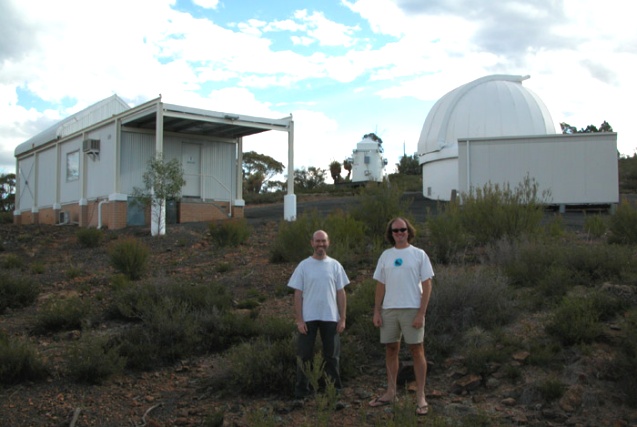
Siding Spring: Robert McNaught (left) and Gordon Garradd (right) in front of the Uppsala dome and its office (right) in 2003.